KNIPE, FLEMING (1843-1879). Corporal, 162nd New York Infantry, Company K. Of Irish origin, Knipe enlisted at New York City as a corporal on September 4, 1862, mustered into Company K of the 162nd New York on October 18, but was reduced in rank to private on October 31. On August 1, 1864, he was promoted to corporal of his company and mustered out on October 12, 1865, at Savannah, Georgia. His last address was in New York City. He succumbed to Bright’s disease. Section 15, lot 17263, grave 2452.
Civil War Bio Search
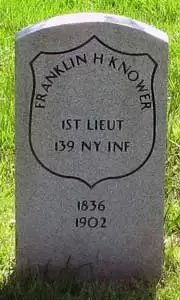
KNOWER, FRANKLIN H. (1836-1902). First lieutenant, 139th New York Infantry, Companies I and C. A native of Boston, Massachusetts, Knower enlisted at Brooklyn on August 20, 1862, mustered into Company I of the 139th as a sergeant two days later, and was promoted to quartermaster sergeant a month later on September 9. He mustered into Company C of the regiment as a first lieutenant on September 10, 1864, and mustered out with his company on June 19, 1865, at Richmond, Virginia. He last lived at 316 10th Street in Brooklyn. His death was caused by nephritis. Section 121, lot 11189, grave 28.
KNOWLES, JOHN W. (1833-1907). Captain, 3rd New York Infantry, Companies C, B, and I; private, 8th Regiment, New York State Militia, Company A; 9th New York Infantry, Company B. From May 29-September 10, 1862, Knowles, a native of New York City, served in the 8th New York State Militia as a private. Two weeks after his discharge, he re-enlisted as a private at New York City on September 24, 1862, immediately mustered into the 9th New York, and transferred into Company C of the 3rd New York on May 6, 1863. At some point, he was promoted to first sergeant, and then rose to first lieutenant on March 24, 1865, effective upon his transfer that day to Company B. He was transferred to Company I on June 12, 1865, upon his promotion that day to captain, and mustered out on August 28 of that year at Raleigh, North Carolina. Knowles applied for and received an invalid pension in 1892, certificate 868,371. His last residence was 27 Van Buren Street in Brooklyn. His death was attributed to cancer. In 1904, Mary Knowles, who is interred with him, applied for a widow’s pension that was granted under certificate 604,061. Section 65, lot 5538.
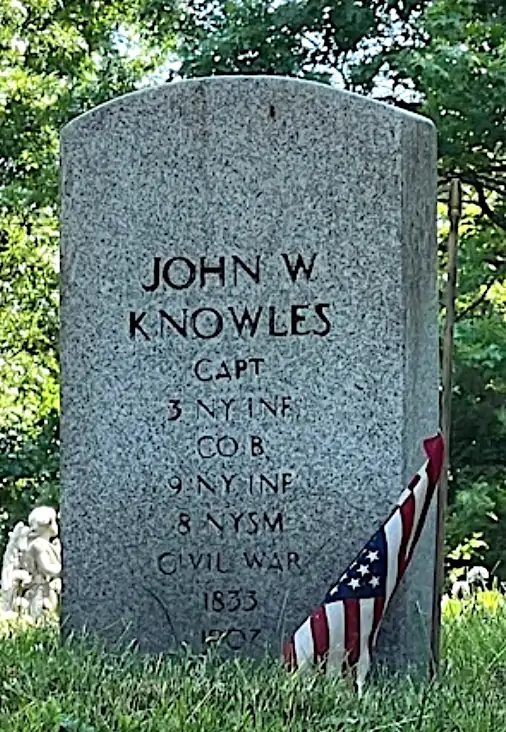
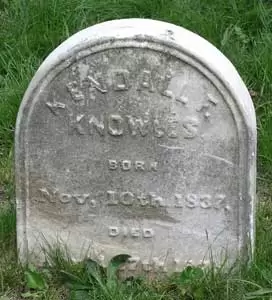
KNOWLES, KENDALL F. (1837-1875). First lieutenant, 182nd New York Infantry, Companies B, I, and E; private, 11th New York Infantry, Company E. A native of New York, he enlisted there as a private on April 20, 1861, mustered into the 11th New York the next month on May 7, and was discharged on September 18 of that year. Knowles re-enlisted as a sergeant on September 24, 1862, and mustered into Company B of the 182nd New York two months later on November 17, the same date that he was promoted to first sergeant. Rising through the ranks, he was promoted to second lieutenant on June 5, 1864, effective upon his transfer to Company I on January 12, 1865, and later promoted to first lieutenant on April 1, 1865, effective upon his transfer to Company E on June 6 of that year. He mustered out on July 15, 1865, at Washington, D.C. At the time of his death from pneumonia, he resided in New York City. Section K, lot 15154, grave 40.
KNOWLTON, BENJAMIN F. (1844-1879). Private, 10th New Hampshire Infantry, Company A. Born in Newbury, Vermont, he was a resident of Manchester, New Hampshire, when he enlisted as a private on August 14, 1862, and mustered into the 10th New Hampshire on August 23. On November 12, 1862, he deserted at Gaines’ Mill, Virginia. He last lived at 8th Street and East Boulevard in New York City. Section 173, lot 21567.
KNOX, JOSEPH (1828-1870). Corporal, 15th New York Engineers, Company G. A native of New York City, Knox enlisted there as a private on May 9, 1861, and mustered into the 15th Engineers on June 17. On December 21, 1862, he was promoted to corporal, and mustered out on June 25, 1863. His last residence was on Blackwell’s Island (now Roosevelt Island), New York, where his death was attributed to drowning. Section 80, lot 3167.
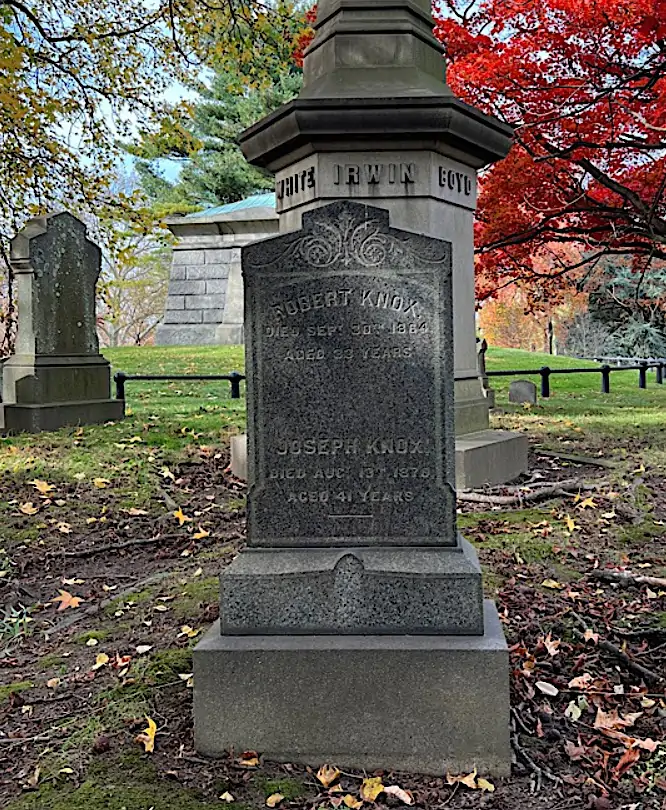
KOBBE, PHILIP (or PHILLIP) FERDINAND (or T.) (1842-1906). Private, 7th Regiment, New York State Militia, Company K. Kobbe, who was born in New York City, was educated in Germany. He enlisted at New York City as a private in 1863. He mustered into Company K of the 7th Regiment where he served for three months. In civilian life, he worked for the United States Lighting Company which was absorbed by Westinghouse in 1890. He was elected the vice-president and treasurer of that corporation and was also associated with the company’s French and British divisions. His obituary in The New York Times noted that he was a member of the Calumet and Richmond Country Clubs and the Society of the Colonial Wars. Although he died, of endocarditis, at his country home in Stockbridge, Massachusetts, his last address was at Harbor Hill in Staten Island. Section 93, lot 44.
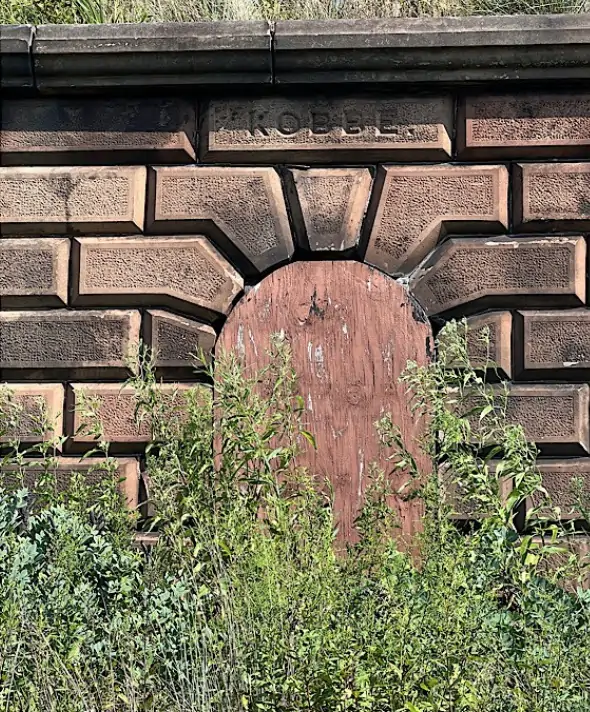
KOCH (or KOCHE), CHRISTIAN (1838-1874). Private, 9th Massachusetts Infantry, Company K; 32nd Massachusetts Infantry, Company K. Of German origin, Koch was born in Kirrweiler (Pfalz), Bayern, and was a cooper and New York City resident when he joined the Union forces. He enlisted as a private on August 21, 1863, and mustered that day into the 9th Massachusetts. On June 6, 1864, he was transferred into Company K of the 32nd Massachusetts and mustered out on June 29, 1865, at Washington, D.C. His last residence was 34 South 8th Street in Brooklyn. Section 186, lot 20703.
KOCH, PHILIP (1822-1893). Corporal, 45th New York Infantry, Company D. Koch, who was born in Germany, enlisted as a corporal at New York City on September 13, 1861, and mustered immediately into the 45th New York. On August 29, 1862, he was wounded in action at the Battle of Second Bull Run, Virginia. On February 27, 1863, he deserted at Potomac Creek, Virginia. His last residence was 127 55th Street in Brooklyn. Section 156, lot 20042.
KOENIG, CARL (1819-1887). Wagoner, 46th New York Infantry, Company G; Veteran Reserve Corps. A German native, Koenig enlisted as a private at New York City on September 6, 1861. His muster roll notes that he was present as a wagoner on April 10, 1863. On January 15, 1864, he transferred into the Veteran Reserve Corps from which he was discharged on an unknown date. The 1876 New York Directory lists him in the lock business at 119 Greenwich Avenue. Koenig last lived at 23 Charles Street in Manhattan. He died from cancer on September 22, 1887. On May 11, 1890, he was re-interred to Section 138, lot 26546.
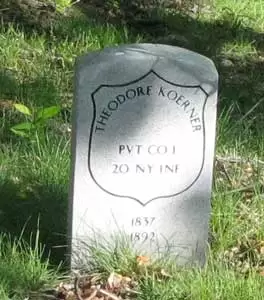
KOERNER, THEODORE (1838-1892). Private, 20th New York Infantry, Company I. Born in Ireland, Koerner enlisted as a private on May 3, 1861, at Williamsburg, New York, mustered into the 20th New York three days later, and mustered out at New York City on June 1, 1863. His pension record indicates additional service in the 6th Regiment, United States Veteran Volunteer Infantry, Company C. In 1890, his application for an invalid pension was approved, certificate 844,717. He last lived in New York City. Section 21, lot 11723.
KOHLER, CHARLES H. (1841-1896). Second lieutenant, 1st New York Engineers, Company C. Kohler was born in New York. His Ancestry.com family tree shows that he was living in New York City in 1855 and 1860. The 1855 New York State census shows Charles as the oldest son with four younger siblings: Frederick, Adelaide, George and Josephine. According to the 1860 census, Charles was living with his parents, Fredrick and Margaret Kohler, in New York City. Employed as a clerk, he had an older brother and five younger siblings. Frederick is listed as the older brother on this census and Jane and Henry are newly added to the family. Given that a Frederick C. Kohler (see) was also in the 1st Engineers and they are buried in the same lot, it is likely they were brothers.
During the Civil War, Kohler enlisted as a private at New York City on March 18, 1862, and mustered into Company C of the 1st New York Engineers on April 17. His muster roll notes that he was 5′ 11″ tall with blue eyes, light hair and a light complexion. He re-enlisted at Jacksonville, Florida, on March 30, 1864, at which time he was promoted to commissary sergeant and transferred to the Field and Staff. He then became a quartermaster sergeant on February 1, 1865, and a second lieutenant on June 17, 1865, but did not muster in that rank.
His online family tree shows that he married Mary in about 1870. By 1880, they were living in Stony Point in Rockland County, New York. The 1880 census shows them living in Stony Point with their four daughters: Mayra (8), Sarah (7), Mary (6) and Hellen (1). In 1889, he was reported to be exploring in South Dakota, as per his online family tree.
The Veterans Census of 1890 confirms Kohler’s Civil War service, notes his rank as lieutenant and states his length of service as three years, three months and 11 days. In 1894, Charles applied for and received an invalid pension, certificate 887,141. Shortly after his death in 1896, Mary A. Kohler applied for and was granted a widow’s pension, certificate 492,180.
His obituary notes his death in Troy, New York, and names him as an “old soldier’ who fought in the war of the sixties and was a lieutenant in the 1st New York Engineers. That obituary details that he was a member of the Edward Pye Post of the Grand Army of the Republic, located in Haverstraw, for many years. As per Green-Wood records, he was married and last lived at Terrace Place and Pawling Avenue in Troy, New York. His death was attributed to phthisis pulmonalis (tuberculosis). Section 147, lot 22161.
KOHLER, FREDERICK C. (1843-1884). Private, 1st New York Engineers, Company H. A native New Yorker, he enlisted and mustered into Company H of the 1st New York Engineers on April 1, 1865. As per his muster roll, he was a boatman who was 5′ 6½” tall with hazel eyes, brown hair and a fair complexion. He mustered out on June 30, 1865, at Richmond, Virginia. Although he applied for a pension in 1871, application 170,504, he never received one. As per the 1883 New York City Directory, he was a photographer. He was likely the brother of Charles Kohler (see). He last lived at 2390 First Avenue in Manhattan. Section 147, lot 22161.
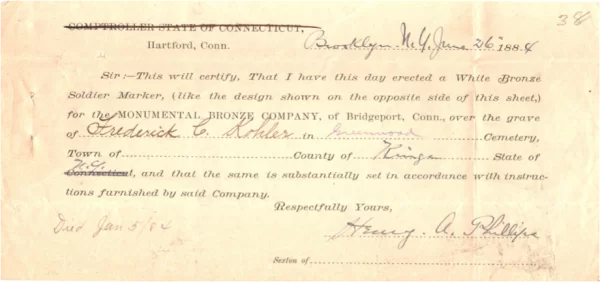
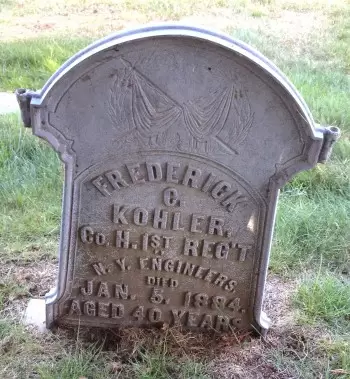
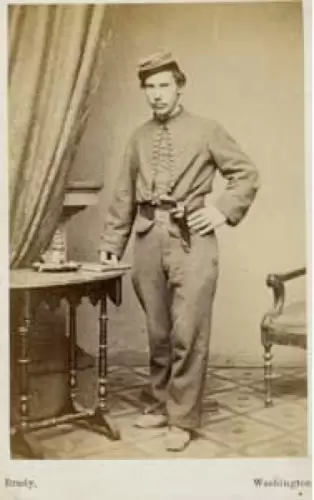
KOLLMYER, JAMES H. (1839-1907). Private, 84th New York (14th Brooklyn) Infantry, Company E; 5th New York Veteran Infantry. On April 18, 1861, he enlisted at Brooklyn, mustered into the 14th Brooklyn a month later on May 23. As per his muster roll, he was absent without leave (deserted) from November 23, 1861, through February 22, 1862, and detached to the brigade rear guard from September through November 1862. As of April 23, 1863, he was listed as absent due to sickness and was transferred into the Invalid Corps per General Order 221 on July 1, 1863. Subsequently, Kollmyer was transferred into the 5th Veterans on June 2, 1864. In 1884, he applied for an invalid pension that was granted under certificate 285,180. His obituary in the Brooklyn Daily Eagle, which noted his Civil War service with the 14th Brooklyn, stated that he had never fully recovered from the wounds that he suffered in one of the early battles. His last residence was 488 16th Street in Brooklyn. His death was attributed to nephritis. Emma Kollmyer applied for and received a widow’s pension in 1907, certificate 644,232. Section 51, lot 10159.
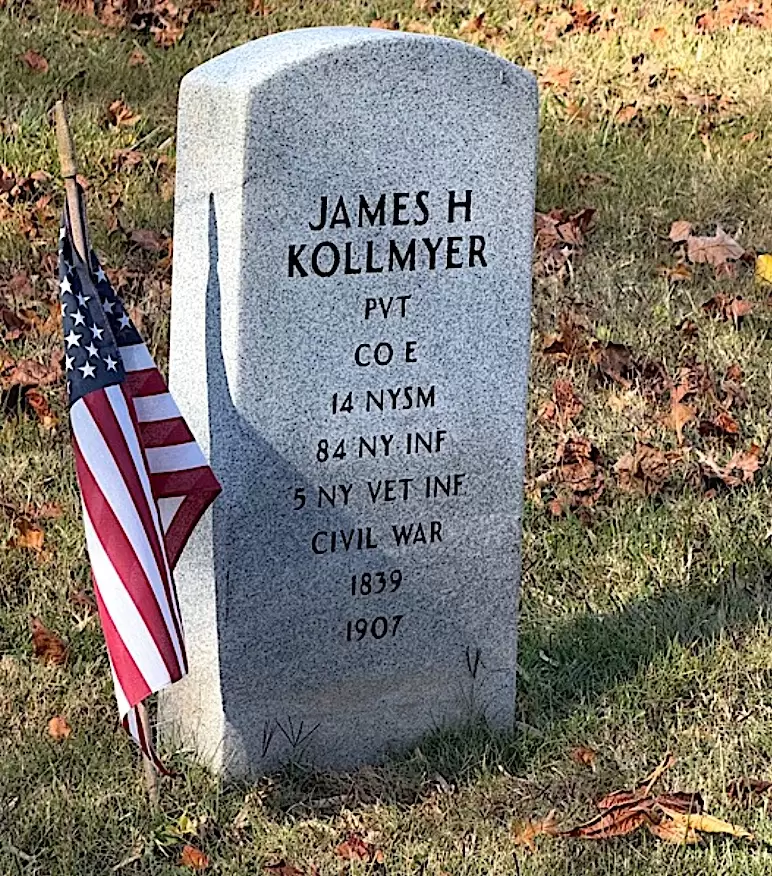
KOOPMANN (or KOOPMAN), HENRY A. (1825-1874). Private, 1st New Jersey Cavalry, Companies A and K. Of German origin, Koopmann enlisted as a private on January 21, 1864, mustered into Company A of the 1st New Jersey Cavalry the next day, and was transferred into Company K at some point before he mustered out on July 24, 1865. He last lived at 2 Grace Street in Jersey City, New Jersey. Section 67, lot 1955.
KOTCH (or KOCH), WILLIAM (1827-1898). Sergeant, 164th New York Infantry, Company K. Born in Germany, Kotch enlisted as a private on November 18, 1862, and mustered into the 164th the next day. He was promoted to corporal, then sergeant on November 1, 1864. He mustered out at Washington, D.C., on July 15, 1865. At the time of his death, he was living at 901 Atlantic Avenue in Brooklyn. Section C, lot 22038, grave 2.
KOTMAN, LOUIS E. (1831-1878). Private, 7th Regiment, New York State National Guard, Company B. Born in New York, Kotman enlisted as a private in 1863 for a tour of 30 days and mustered into Company B of the 7th Regiment. He last lived in Greenwich, Connecticut. Section 112, lot 14396.
KOZLAY, EUGENE ARTHUR (1825-1883). Brigadier general by brevet; colonel, 54th New York Infantry. Originally, Kozlay was originally interred in Green-Wood in lot 17245, grave 1090, but his remains were removed to Evergreen Cemetery in 1917. A native of Hungary, Kozlay enlisted at Hudson City, New Jersey, on August 30, 1861, and was commissioned into the Field and Staff of the 54th New York Infantry as its colonel on November 20, 1861. He commanded the 54th at the Battle of Cross Keys, Virginia, on June 8, 1862, and resigned on March 18, 1863. On March 19, 1864, he was again commissioned into the 54th New York Infantry as colonel. On March 13, 1865, he was promoted to brigadier general by brevet “for gallant and meritorious service during the War.” He mustered out at Charleston, South Carolina, on April 14, 1866.
Kozlay was a member of the G.A.R. Rankin Post #10. In 1869, he was dismissed from his position at the Custom House because he was a member of the Copperhead Party. When questioned by his supervisor, he noted his service to his country during the Civil War and his refusal to give up his political affiliation even if it espoused a minority viewpoint. While working as chief draftsman in the Map Bureau of the New York Department of City Works in 1876, he was among those prostrated by the heat wave in July of that year. His last residence was at 498 Kent Avenue, Brooklyn.
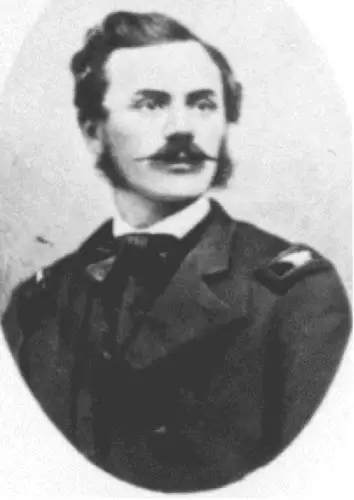
KRAEMER (or KREAMER), GEORGE (1835-1917). First lieutenant, 8th Regiment, New York State Militia, Company F. Kraemer was born in New York City. As per his pension index card, Kraemer served in Company F of the 8th Regiment from April 1861 through August 2, 1861. In 1862, Kraemer returned to the same regiment and company as a first lieutenant, and served for three months. The 1890 Veterans Census, which confirms his Civil War service, lists him in the 8th Regiment as a sergeant. In 1903, his application for an invalid pension was approved, certificate 1,070,726. The 1910 census notes that he lived on Kelly Street in the Bronx, had been married forty-five years, was a veteran of the Union Army and was retired. His last address was 733 Kelly Street in the Bronx. Kraemer’s death was attributed to senility. Section 172, lot 15138.
KRAFT (or CRAFT), DAVID P. (1841-1903). Private, 70th New York Infantry, Company B; 86th New York Infantry, Company D; 7th Veteran Reserve Corps, Company B. Born in Fairfax, Virginia, Kraft was living in Washington, D.C., at the time of the 1850 census. During the Civil War, he enlisted as a private on August 8, 1862, at New York City, and mustered into the 70th New York that day. As per his muster roll, which indicates that he was also borne as David Craft, he was a segar [cigar] maker who was 5′ 5″ tall with black hair, black eyes, and a dark complexion. On May 5, 1864, he was wounded at Wilderness, Virginia. He was transferred into the 86th New York the next month on June 22, joined the 7th Veteran Reserve Corps on December 16 of that year, and mustered out on June 22, 1865, at Washington, D.C.
In 1869, Kraft applied for and received an invalid pension, certificate 101,262. The 1870 census indicates that he was living in Manhattan and working as a cigar maker; the 1880 census states that he was living in Brooklyn. His last was address was 363 53rd Street in Brooklyn. After his death, Elizabeth Kraft applied for and received a widow’s pension, certificate 562,757. Section 203, lot 26648, grave 3.
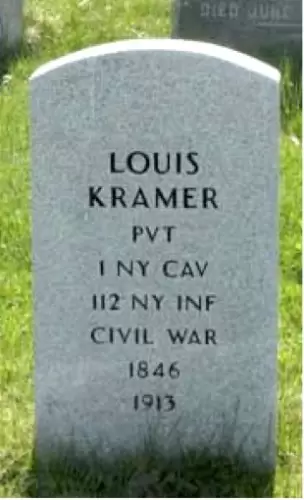
KRAMER, LOUIS (1846-1913). Private, 1st New York Cavalry; 112th New York Infantry. A native of Germany, Kramer enlisted as a private at Brooklyn on December 21, 1864, mustered that day into the 1st New York Cavalry but was not assigned to a company, and transferred into the 112th New York Infantry on December 30 of that year. He last lived in Manhattan. He succumbed to pneumonia. Section 128, lot 31394, grave 260.
KRANCHER, FRIEDRICH (or FREDERICK) (1829-1881). Private, 173rd New York Infantry, Company E. Originally from Germany, Krancher enlisted at Brooklyn as a private on September 2, 1862, mustered into the 173rd New York on October 30, and was discharged on October 18, 1865, at Savannah, Georgia. In 1879, his application for an invalid pension was granted, certificate 221,157. His last residence was 128 Union Street in Brooklyn. After his death, his widow applied for and received a pension, certificate 197,926. Section 204, lot 29918, grave 2.
KRAUSE, LOUIS (1823-1872). Assistant surgeon, 54th New York Infantry. Born in Prussia, Krause enlisted as an assistant surgeon at Washington, D.C., on March 4, 1863, and was immediately commissioned into the Field and Staff of the 54th New York. He was discharged on March 18, 1864, at Folly Island, South Carolina. He last lived on Second Avenue in New York City. His death was caused by gastroenteritis. Section 17, lot 17245, grave 639.
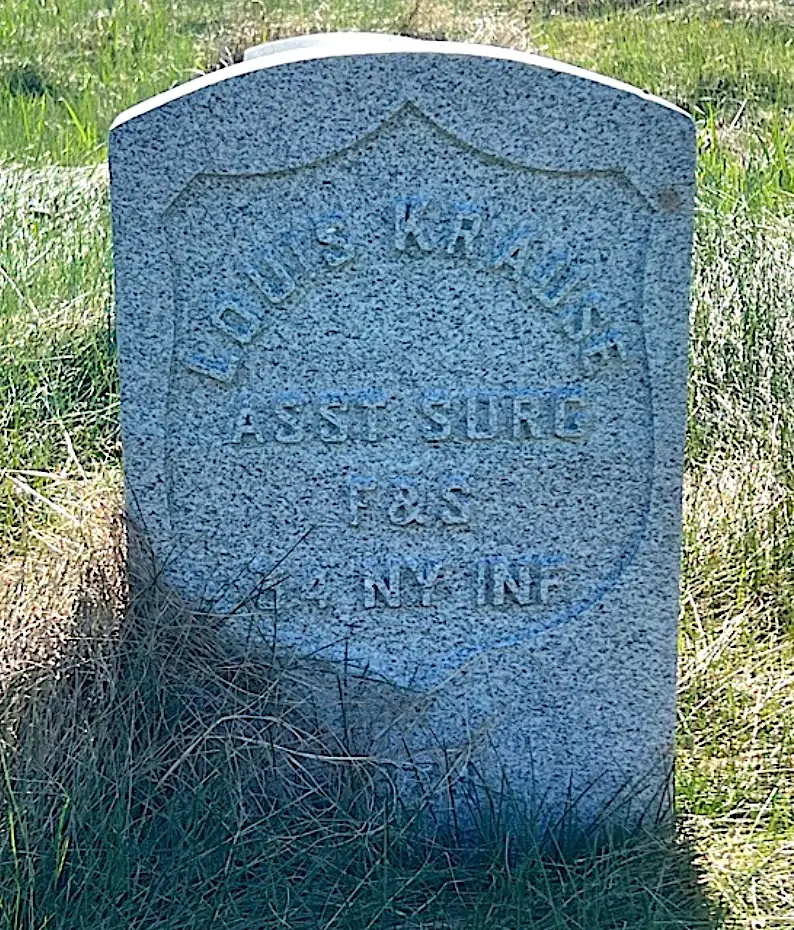
KREBS, HENRY F. (1837-1883). Private, 7th New York Infantry, Company I. Originally from Holland, he enlisted as a private at New York City on October 14, 1861, mustered into the 7th Infantry that same day, and mustered out at New York City on May 8, 1863. His last address was 38 Prospect Street in Brooklyn. His death was attributed to congestion of the brain. Section 76, lot 4335.
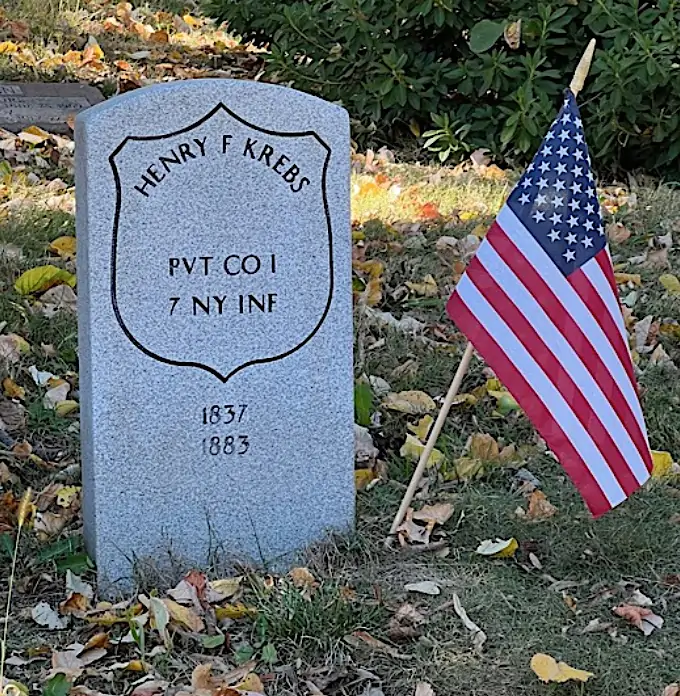
KREHBIEL, JOHN D. (1831-1891). Captain, 41st New York Infantry, Companies I and H. Of German birth, he enlisted at New York City as a captain on June 6, 1861, and was commissioned into Company I of the 41st New York that same day. He was transferred to Company H on November 1, 1861, and was discharged on February 12, 1862. Krehbiel applied for an invalid pension in 1882, application number 465,467 (no certificate number listed). His last address was on East 82nd Street in Manhattan. He died of heart disease. Elizabeth Krehbiel applied for and received a widow’s pension in 1891, certificate 470,915. Section 192, lot 27511.
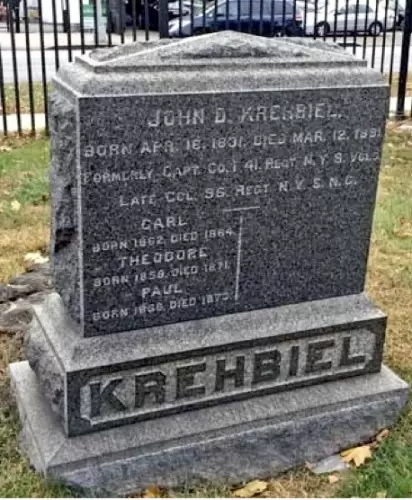
KREHER, AUGUST (or CARL AUGUST) F. (1834-1880). Private, 29th New York Infantry, Company B. Born in Germany, Kreher enlisted as a private at New York City on May 12, 1861, mustered into the 29th New York on June 6, and mustered out on June 20, 1863, at New York City. Kreher last resided at 407 Broome Street in Manhattan. He succumbed to pneumonia. In 1890, his widow, Johanna Kreher, filed for and was granted a pension, certificate 367,492. His remains were removed from Lutheran Cemetery and he was re-interred at Green-Wood on December 16, 1900. Section 196, lot 307010.
KREKEL, WILLIAM (1843-1897). Private, 9th New York Infantry, Company H. A native of Germany, he enlisted at New York City on May 3, 1861, mustered into the 9th New York the next day, and mustered out at New York City on May 20, 1863. He died in an accidental drowning and last lived in Newark, New Jersey. Section 115, lot 18454, grave 11.
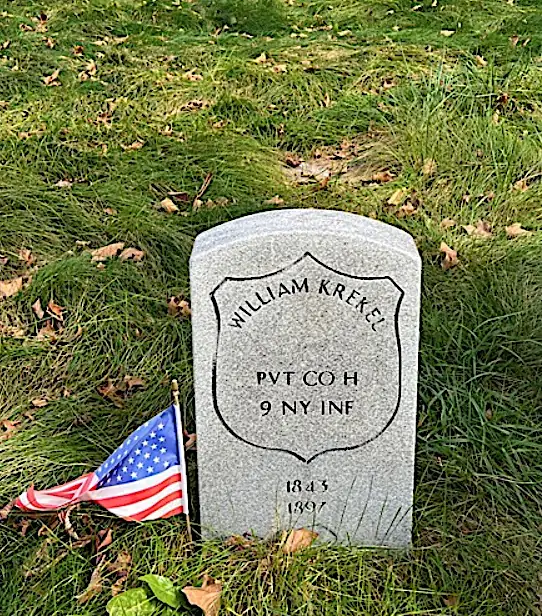
KREY, RUDOLPH (1836-1880). Corporal, 8th New York Infantry, Company K. Krey, a native of Germany, enlisted as a private on April 23, 1861. During his service, he was promoted to corporal. Exactly two years after he mustered into the 8th New York, he mustered out at Brooks’ Station, Virginia. Krey became a naturalized citizen on March 31, 1869. The 1880 census and New York City Directory show that he was employed as a fresco painter. At the time of his death, he was living at 202½ Kosciusko Street in Brooklyn. His death was attributed to Bright’s disease. Harriet Krey applied for and was granted a widow’s pension in 1891, certificate 355,661. Section F, lot 20304.
KROLLPFEIFFER, JR., EDWARD (1843-1895). Unknown rank, 71st Regiment, New York State Militia, Company A. A Brooklynite by birth, he was the son of a prominent member of the Produce Exchange. A descendant, John Krollpfeiffer, who has written a biography of Edward, provides many of the details about Edward’s personal and business life that are included in this entry. Edward attended an academy in Versailles, France, and was also educated at the Department of Public Education in Brooklyn where he was issued a report card stating that he was “A Good Boy.” A letter from Krollpfeiffer to his parents from an unnamed university states, “My studies here at the university are arduous, and I look forward to visiting home in the coming springtime.” Krollpfeiffer was fluent in German, French, Italian and Spanish. The descendant has pamphlets and theater tickets from performances that Edward attended in Rome and Venice.
Krollpfeiffer’s pension record indicates service in the 71st New York State Militia. As per John Krollpfeiffer, Edward enlisted on April 19, 1861, in Company A of the 71st New York State Militia, for a period of three years. His descendant relates that the uniform chevrons suggest that he was a sergeant major in the 71st National Guard; it is not known whether the promotion occurred during or after the Civil War. According to his obituary in the New York Herald, he was with the 9th Regiment at the Battle of Bull Run. His descendant notes that Edward was a private business agent during 1862 and that he possesses a pass dated December 19, 1863, noting that Edward accompanied Mlle. Felicita de Vestvali, an actress and opera singer, to the front lines.
Intriguingly, during 1862 through 1865, while performing his military service, Krollpfeiffer was also working as a private business agent and public relations person for several prominent people including Julia Raymond, a stage actress; Francis Bang, a lawyer; and Charles D. Fredericks, a photographer.
In 1866, Edward married Anna Hodges Work at the Plymouth Church in Brooklyn; the officiant at the ceremony was Henry Ward Beecher (see). The couple had two daughters, Grace, born in 1868 and Edna, born in 1889. In 1867, Edward filed for bankruptcy, as per an unnamed source.
During his lifetime, Krollpfeiffer had many jobs. His descendant indicates that he joined his father’s brokerage at 42 Pine Street on May 1, 1871; the firm was then renamed E. Krollpfeiffer & Son. That enterprise bought and sold commercial paper. By March 1, 1875, Edward was the sole proprietor and merged or operated out of Hiram Pool’s bank and commercial paper brokerage at 2 Nassau Street, New York City. Among other business ventures, his descendant notes that Krollpfeiffer was a coal merchant, notary, and partner of the Wells Company Photographers at 26 West 14th Street in New York City. The descendant possesses business cards from the last named company and Edward’s notary seal.
After the Civil War, Edward served in the 9th Regiment of the New York State Militia. He was discharged from the 9th Regiment of the New York State National Guard on June 25, 1877, as a sergeant. At the time of his discharge, he was 5′ 6¾” tall with a prominent nose, dark brown eyes and hair, a round chin, small mouth and dark complexion.
After 26 years of marriage, Krollpfeiffer divorced his wife. His descendant notes that the divorce affected him emotionally and financially. He states that Edward’s net worth in 1888 was about $100,000, the equivalent of $3 million in 2022. As per the divorce papers, which John Knollpfeiffer possesses, Edward was a partner in the firm of Martin Rothbarth, a hops brokerage at 76 Broad Street and also in London. (At some point after 1908, Rothbarth was accused of bank fraud.) According to the Brooklyn Directory of 1888, Edward was employed as a clerk. He filed for bankruptcy after the divorce.
Soon after his divorce, he married Caroline (Carolyn) Ledoux Garby in Brooklyn. They had a son, Raymond Marchaise Knollpfeiffer, in 1895. John Knollpfeiffer relates that his ancestor was active in social circles, traveled frequently to Liverpool on the White Star Line and owned real estate. Among his properties in Brooklyn were 329 and 407 Clinton Avenue; 829 State Street and a summer home in Bath Beach.
His last residence was 73 Grove Street in Brooklyn. His death was attributed to a cerebral embolism. As per his descendant, Krollpfeiffer’s remains were cremated at Fresh Pond Crematorium and then transported to Green-Wood where he was interred with family members. In 1932, Caroline L. Ryder, his second wife, applied for and was granted a widow’s pension, certificate A-5-11-34. Section 114, lot 16911, grave 6.
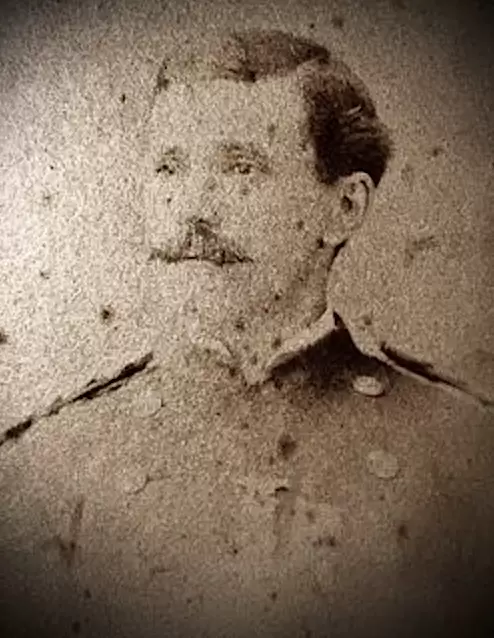
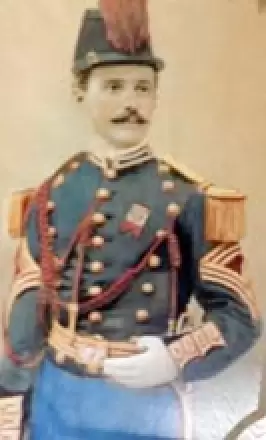
KROOS (or KROOSS), WILLIAM (1838-1883). Sergeant, 4th Cavalry, United States Army, Company I. Born in Germany, he served with the 4th Cavalry of the U.S. Army but there are no further details about his service. He died at St. Vincent’s Hospital in New York City of complications of a fracture and dislocation. Section L, lot 18927.
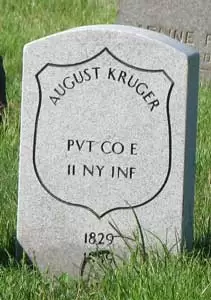
KRUGER, AUGUST (1829-1889). Private, 11th Regiment, New York State National Guard, Company E. Of German birth, Kruger enlisted as a private at New York City on June 16, 1862, and mustered into the 11th National Guard on that day. He mustered out on September 16 of that year. His last residence was in Flatbush, Brooklyn. Kruger died from acute dysentery and asthma. Section 6, lot 20118, grave 688.
KRUGER, HARRY (or HENRY) J. (1840-1871). Private, 71st Regiment, New York State National Guard, Company D. A native of New York City, he enlisted there on May 27, 1862, mustered in the same day, and mustered out after three months on September 2 at New York City. He last lived on Buena Vista Avenue in Yonkers, New York. Section 158, lot 19128, grave 187.
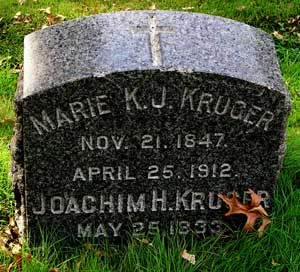
KRUGER, JOACHIM H. (1833-1920). Private, 9th New York Light Artillery; 7th New York Light Artillery, Company F. Born in Denmark, Kruger enlisted as a private on January 1, 1862, at New York City, mustered into the 9th New York Light Artillery on January 7, and was discharged on January 23, 1864, at Fort Reno, D.C. He had subsequent service with Company F of the 7th New York Light Artillery. His last residence was 276 18th Street, Brooklyn. Section 87, lot 1715, grave 371.
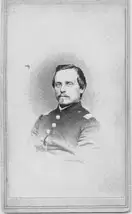
KRZYZANOWSKI, WLADIMIR B. (1824-1887). Brigadier general by brevet; brigadier general, Second Brigade, Division 3; colonel, 58th New York Infantry. Krzyzanowski was originally interred at Green-Wood. On October 9, 1937, (or October 13, 1937, according to another source), his remains were moved with military honors to Arlington National Cemetery at which time President Franklin D. Roosevelt praised Krzyzanowski’s devotion to his adopted land. Born July 8, 1824, in Raznova, Poland, his ancestry included noble parents and first cousin Frederick Chopin. Forced to flee Poland after participating in a failed insurrection, he came to the United States from Hamburg, Germany. He learned the language, became a civil engineer before the Civil War and was instrumental in the westward expansion of the railroads.
After raising a militia in the Washington, D.C., area (Turner’s Rifles), Krzyzanowski came to New York and raised the 58th Infantry known first as Morgan’s Rifles and later, as the “Polish Legion.” He was promoted to brigadier general on November 29, 1862, and led the Second Brigade from June 26, 1862-September 25, 1863, commanding the Army of Virginia and the Army of the Potomac. Among the battles in which he participated were Cross Keys in the Shenandoah Valley, and Second Bull Run and Chancellorsville in Virginia. During the Battle of Gettysburg, Pennsylvania, he was injured when his horse was killed in battle, but he refused to leave the battlefield. Jack D. Welsh, M.D., in Medical Histories of Union Generals (1996, p. 197), states that Krzyzanowski suffered from occasional pulmonary hemorrhages and asthma attacks after this injury. He subsequently commanded the Army and Department of the Cumberland from September 25, 1863-January 8, 1864, and from March 7, 1864-April 16, 1864. From July 15, 1864-March 15, 1865, he commanded the defenses of the Nashville and Chattanooga Railroads in Tennessee. On March 13, 1865, he was brevetted to brigadier general when his earlier appointment expired without confirmation.
After the War, Krzyzanowski was given duties in the governing of Alabama, and was appointed governor in Florida, Georgia, and Virginia. Although some attribute his name as the first governor of Alaska, Alaskan researchers claim that this is a myth that is widespread but untrue and undocumented. He then worked for the United States Treasury Department in Panama and as a customs agent in New York in 1883, serving there until poor health caused him to transfer to the drier climate in Tucson, Arizona, in 1886. (Ultimately, he was too frail to take the transfer.) As per his obituary in the New York Tribune, that detailed his Civil War service, Krzyzanowki organized the Adolph Von Steinwehr Post #192 of the G.A.R. and was an active Republican. On the 50th anniversary of his death, a special memorial ceremony was organized by Polish patriotic groups on January 31, 1937, that included a military escort to the 69th Regiment Armory in Manhattan. His portrait was presented two years later to the New-York Historical Society.
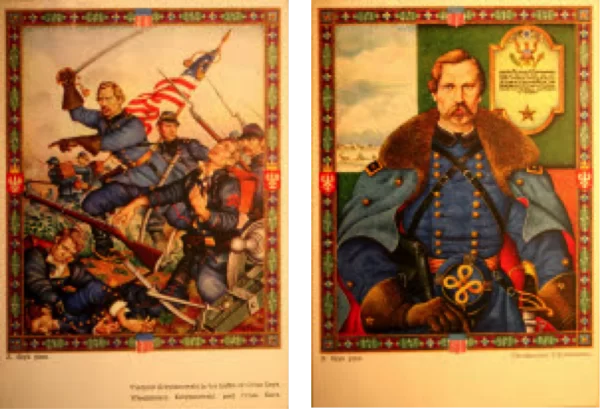
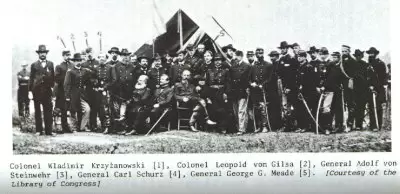
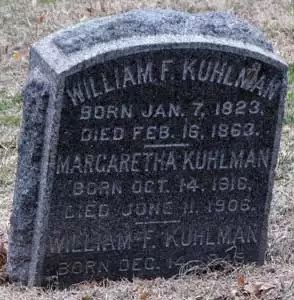
KUHLMAN (or KUHLMANN), WILLIAM F. (1823-1863). Corporal, 20th New York Infantry, Company H. Of German origin, he enlisted as a corporal at New York City on May 3, 1861, mustered into the 20th New York three days later, and was discharged for disability on August 2, 1861, at Camp Hamilton, Virginia. Kuhlman’s last residence was 142 First Avenue in Manhattan. Section 115, lot 4196, grave 908.
LA BARTE (or LABARTE, La BARTER), JOSEPH MOORE (1826-1894). Landsman, United States Navy. La Barte was born in Ireland. He enlisted as a private in the United States Marine Corps, part of the Navy, on May 29, 1848, mustered in that July, and served aboard the USS St. Louis. He served on that ship and then was a marine at the Brooklyn Navy Yard. The New York State census of 1855 shows that he was head of the household, lived in Brooklyn and worked as an apothecary. A receipt from the Brooklyn Navy Yard, dated in 1855, shows that he still was active in the Marine Corps.
During the Civil War, La Barte enlisted as a landsman in the United States Navy at New York City for one year on August 9, 1861. As per his papers, he was an apothecary, and had previous Naval service of three and a half years. He described himself as 5′ 7½ tall with blue eyes, bald and light hair. Although that enlistment data shows a birth year of 1831, that is incorrect; other biographies and census records show that he was born in 1826.
At the time of the 1865 New York State census, he was married and lived in Brooklyn. The 1870 census, which spells his surname as La Barter, reports that was married, lived in Brooklyn, worked as a druggist and had a personal estate valued at $10,000. According to the 1880 census, he still worked as a druggist and lived in Brooklyn with his wife, Adelaide. The apothecary shops, which he owned, were located at 483 Fulton Street in Brooklyn and 614 Fifth Avenue in New York City. He last lived in Brooklyn. Section 30, lot 11451.
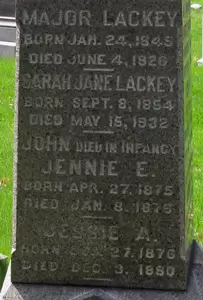
LACKEY, MAJOR J. (1845-1926). Corporal, 7th New York Heavy Artillery, Companies I and D; private, 18th New York Infantry, Company B. Lackey was born in Albany, New York. A clerk at the outbreak of the Civil War, Lackey enlisted at Albany as a private on April 14, 1861, at age sixteen (pretending to be eighteen). On May 17, 1861, he mustered into the 18th New York, and was detailed on recruiting service in December 1861. Subsequently, Lackey was detailed to the Ambulance Corps on August 12, 1862, then returned to his regiment on May 13, 1863. He mustered out with his company on May 28, 1863, at Albany. Three months later, he mustered into Company I of the New York 7th Heavy Artillery on August 18, 1863. At some point in his service, he was reduced in ranks to private. On February 15, 1865, he was promoted to corporal, and was transferred into Company D of his regiment on June 30. He mustered out on August 1, 1865, at Baltimore, Maryland. As per his obituary in the Brooklyn Daily Eagle, which confirms his Civil War service, Lackey was injured in Virginia at the Battles of Ream’s Station and Charles City Crossroads.
Lackey’s application for an invalid pension was approved in 1896, certificate 1,062,035. His obituary notes that he was vice commander of Winchester Post #190 of the G.A.R., and was well known in that organization. At the time of his death, Lackey had been a Brooklyn resident for 55 years and had been married for more than fifty years. He last lived at 426 1st Street in Brooklyn. He died from heart disease. Sarah Lackey applied for and received a widow’s pension in 1926, certificate a-10-14-26. Section 155, lot 25732, grave 1.
LACKEY, PETER (1839-1897). Private, 120th New York Infantry, Company F; 2nd Battalion, United States Veteran Infantry, 33rd Company. Lackey was born in New York City and was a painter by trade. After enlisting as a private at Catskill, New York, on August 22, 1862, he mustered into the 120th New York that same day. As per his muster roll, he was 5′ 6½” tall with grey eyes, brown hair and a light complexion. He was transferred into the 33rd Company of the U.S. Veterans, 2nd Battalion, on September 30, 1863, and mustered out on June 29, 1865, at Washington, D.C.
After the Civil War, Lackey continued to work as a painter; this is confirmed by data on the 1890 Veterans Schedule which also confirms his Civil War service. Although he applied for an invalid pension in 1897, application 574,810, there is no indication that it was certified. He last lived at 554 Third Avenue in Brooklyn. He died of phthisis. Mary Lackey applied for a widow’s pension in 1897, application 663,222, but there is no evidence that it was approved. Section 86, lot 18066, grave 15.
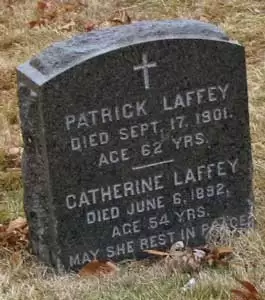
LAFFEY, PATRICK (1839-1901). Private, 7th Veteran Reserve Corps, Company F. Originally from Ireland, Laffey served with Company F of the 7th Veteran Reserve Corps. Further details of his service are unknown. His last residence was 176 27th Street in Brooklyn. Section 85, lot 1594.
La FIURA, JOSEPH (1830-1918). Major by brevet, captain, 10th New York Infantry, Company E; 2nd New York Infantry, Companies I and H. Originally from Italy, La Fiura enlisted as a first lieutenant on April 23, 1861, at Troy, New York. On May 14, 1861, he was commissioned into Company I of the 2nd New York. Upon his promotion to captain on April 23, 1862, he was transferred intra-regimentally to Company H. He resigned his commission on July 29, 1862. Subsequently, he re-enlisted on April 27, 1864, was commissioned into the 10th New York as a captain, and mustered out on June 30, 1865, with the rank of brevet major. His application for a pension was approved in 1901, certificate 1,043,601. At the time of his death from pulmonary phthisis, he lived at 210 Seventh Avenue in Brooklyn. Section 6, lot 20118, grave 87.
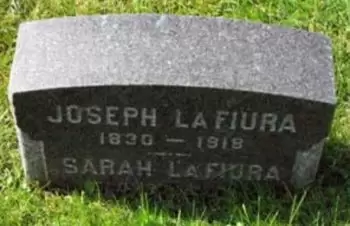
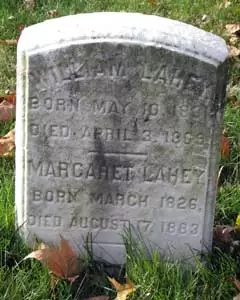
LAHEY, WILLIAM (1831-1869). Sergeant, 170th New York Infantry, Company B. Born in Ireland, Lahey enlisted as a private at New York City on August 27, 1862, and mustered into the 170th New York on October 7. He was promoted to corporal on April 10, 1863, rose to the rank of sergeant on July 15, 1864, and mustered out on July 15, 1865, at Washington, D.C. His last residence was 145 Thompson Street in Manhattan. His death was caused by drowning. Section 85, lot 1595, grave 251.
LAIDLAW, JOHN A. (1840-1869). Sergeant, 56th Regiment, New York State National Guard, Company E; private, 13th Regiment, New York State National Guard, Company I. The Brooklyn Directories for 1862 and 1863 list Laidlaw as an agent. During the Civil War, he served as a private for three months in 1862 with the 13th; then served as a sergeant for 30 days in 1863 with the 56th and served again with the 56th as a private for 100 days in 1864. According to the Brooklyn Directory for 1865, he was an agent; the Brooklyn Directory for 1868 indicates that he was a painter. Robert Laidlaw (see), who is buried in the same lot and served in the same regiments, most likely was his brother. Laidlaw’s last residence was 82 Middagh Street, Brooklyn. The cause of his death was attributed to “intemperance.” Section 105, lot 3931.
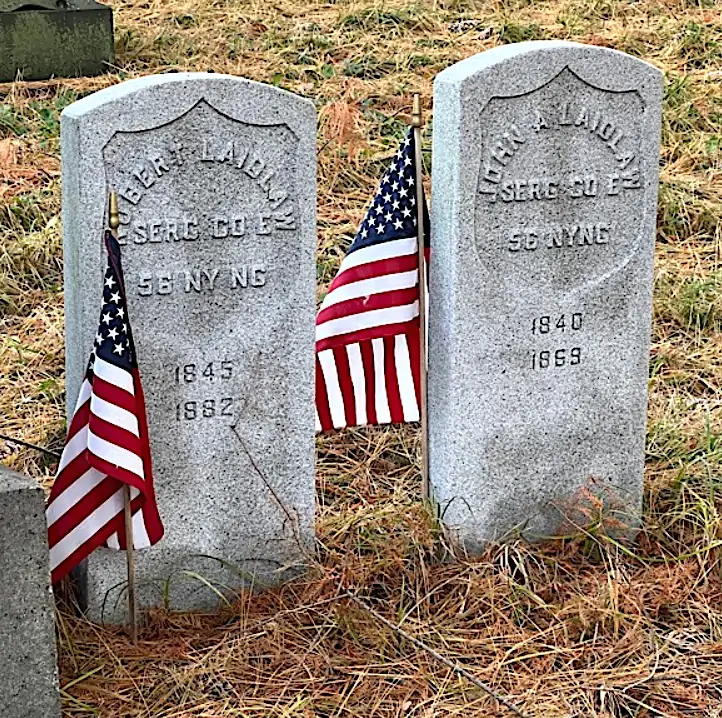
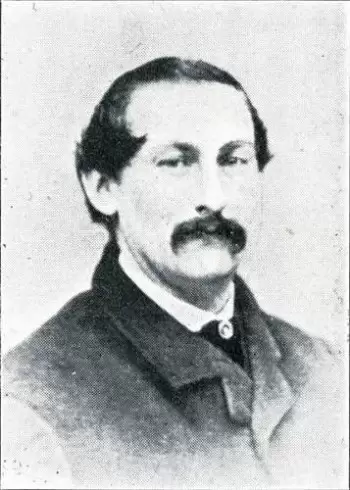
LAIDLAW, LEFFERTS (or LEFFERT) L. (1837-1884). First lieutenant and adjutant, 84th New York (14th Brooklyn) Infantry, Company G. Laidlaw enlisted as a first lieutenant on April 18, 1861, at Brooklyn, and was commissioned into the 14th on May 23. He was promoted to first lieutenant and adjutant on July 1, 1861, given an intra-regimental transfer to Field and Staff on that day, and discharged on August 2, 1861. His last residence was in Parkville, Long Island. His death was caused by heart disease. Section 23, lot 1987.
LAIDLAW, ROBERT (1845-1882). Sergeant, 56th Regiment, New York State National Guard, Company E; private, 13th Regiment, New York State National Guard, Company D. A Brooklynite by birth, Laidlaw enlisted there as a private on May 28, 1862, mustered immediately into the 13th Regiment, and mustered out on September 12 at Brooklyn after serving three months. He returned to the same regiment and company in 1863 and served for 30 days. In 1864, he re-enlisted as a private, served in the 56th Regiment for 100 days, and mustered out with the rank of sergeant. John Laidlaw (see), buried in the same lot, most likely was his brother. Although he last lived in Brooklyn at 72 Middagh Street, he died in Newark, New Jersey, in a railroad accident. Section 105, lot 3931.
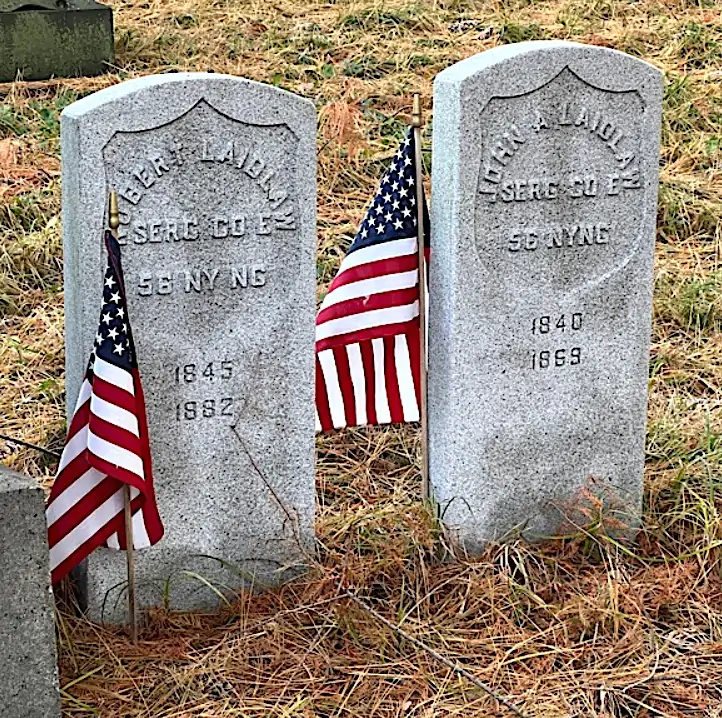
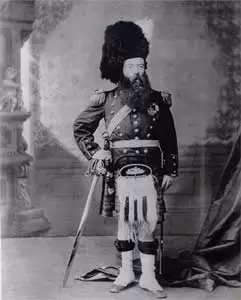
LAING, JOSEPH (1828-1905). Major and lieutenant colonel by brevet; captain, 79th New York Infantry, Company G. Born in Scotland, Laing enlisted as a captain on May 13, 1861, at New York City, and was commissioned into the 79th New York, also called the Highland Guard, that day. The 79th was given a rousing send-off in Manhattan when it paraded up 14th Street and Broadway on June 3, with kilted pipers and officers donned in tartans of their clans. While in command at Bull Run, Virginia, on July 21, 1861, Laing suffered four bullet wounds resulting in injury to his left forearm and a rifle wound to the right side of his head and neck leaving a burn and impaired hearing. He then returned to New York City on furlough. According to an article in The New York Times, dated February 26, 1862, Laing was presented with a claymore (a large Scottish sword) replacing the one he lost on the field, before returning to his regiment where he was assigned to recruiting duty at New York City until January 1863 when he was listed as “present” on the muster rolls. He mustered out on May 31, 1864, at New York City. In November 1864, he applied for an invalid pension. A subsequent letter mentioned that his disability was not noted at muster out. He eventually was granted a pension, certificate 34,487, and requested an increase in 1870. On November 29, 1872, he was brevetted major and lieutenant colonel “for gallant and meritorious services during the late War.”
Articles in The Times in 1874 and 1875 noted that Laing was a major in the 79th Regiment National Guard and was present at military inspections in the City. In 1876, he spoke out against Governor Tilden’s disbanding of the 79th Regiment, calling it an “insult given to the Scottish people in this country….” A lithographer printer whose works are in the Library of Congress, Laing, according to an 1884 article in the Brooklyn Daily Eagle, was working on a chromolithograph, “The Comrade,” a memorial to the Civil War. He last resided at 34 Clinton Avenue in Brooklyn. He died of apoplexy. Section 206, lot 27851, grave 2.
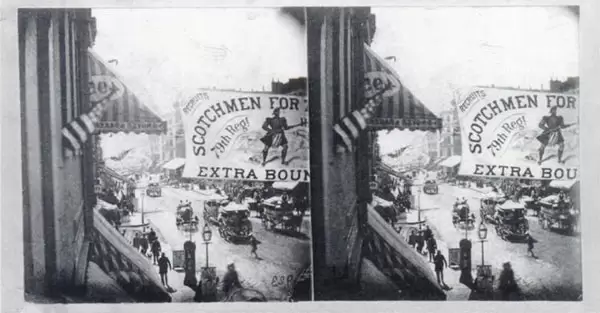
LAIRD, JAMES (1842-1881). First lieutenant, 15th New York Engineers, Companies B and K. Born in New York City, he enlisted there as a private on August 30, 1862, and immediately mustered into Company B of the 15th New York Engineers. On December 29 that same year, he was promoted to quartermaster sergeant and transferred to Field and Staff. On December 8, 1864, Laird was commissioned to the rank of first lieutenant and was intra-regimentally transferred to Company K. He mustered out at Fort Barry, Virginia, on June 13, 1865. He last lived at 215 Varick Street in Manhattan where he died from cirrhosis. Section 127, lot 3611, grave 130.
LAIRD, JOHN (1841-1905). Private, 42nd New York Infantry, Company D; 82nd New York Infantry, Company D; 59th New York Infantry, Company B. Of Scottish birth, he enlisted as a private on August 21, 1863, at the 17th Congressional District in New York, and immediately mustered into the 42nd New York. He was transferred to the 82nd New York on June 28, 1864, where he served for less than a month until his transfer on July 10 to the 59th New York. On May 12, 1864, he was listed as wounded at the United States General Hospital in Washington, D.C. When his company mustered out on June 30, 1865, at Munson’s Hill, Virginia, he was absent because of wounds. His last address was 43 Bradhurst Avenue in Manhattan. His death was caused by cystitis. Section 176, lot 20146.
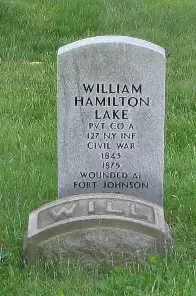
LAKE, WILLIAM HAMILTON (1843-1875). Musician, 127th New York Infantry, Company A. A native New Yorker, Lake enlisted as a musician at New York City on August 11, 1862, and mustered into the 127th on September 8. On July 3, 1864, Major Edward H. Little of the 127th wrote in his field report that Lake suffered a contusion on his shoulder from a shell during the assault on Fort Johnson and Battery Simkins in South Carolina. At some point he was reduced to the rank of private before he mustered out on June 30, 1865, at Charleston, South Carolina. He last lived in New York City. Cystitis was the cause of his death. Section 157, lot 20421.
LAKE, WILLIAM TILDEN (1824-1893). Gunner’s mate, United States Navy. Born in New Jersey, Lake enlisted in the United States Navy in 1862 at an unknown place. He was discharged for sickness in 1863. His last residence was 223½ 22nd Street in Park Slope, Brooklyn. His death was attributed to peritonitis caused by an accidental fall. Section 59, lot 1289, grave 31.
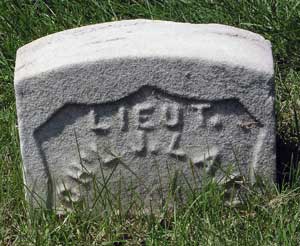
LALLY, MICHAEL J. (1844-1914). Second lieutenant, 93rd Regiment, New York State National Guard, Company I; corporal, 34th New York Infantry, Company C. He enlisted as a musician at New York City on January 7, 1862, and mustered into the 34th on that day. During his service, he was reduced in rank, promoted to corporal on January 24, 1863, and mustered out on June 30, 1863, at Albany, New York. After he re-enlisted and was commissioned into the 93rd New York National Guard as a second lieutenant on July 20, 1864, he mustered out at New York City on November 1, 1864. In 1890, he applied for and was granted an invalid pension, certificate 814,089. At the time of his death from apoplexy, he lived at 189 Garside Street in Newark, New Jersey. Section 3, lot 21025, grave 175.
LAMB, GEORGE H. (1833-1890). Private, 79th New York Infantry. Originally from Philadelphia, Pennsylvania, he enlisted as a private at New York City on January 25, 1864, and mustered immediately into an unassigned company of the 79th New York. As per his muster roll, he was a miller by trade who was 5′ 7½” tall with brown eyes, brown hair, and a dark complexion. He mustered out on May 8, 1865, at Hart’s Island in New York Harbor. He last resided at 340 Hudson Street in Manhattan. Section 206, lot 21347, grave 3.
LAMBERT, EDWARD AUGUSTUS (1813-1885). Brooklyn mayor. Born in New York City, his father was lost at sea, and from the age of twelve he had to support himself. He worked as a clerk in an importing house, then went into the stationery business. As per Find A Grave website, he first entered business with his brother-in-law, Nathan Lane, in a partnership, Lambert & Lane Stationers, before venturing out on his own. His first wife was Elizabeth née Lane who died in 1857. He was a prominent and well-to-do businessman before entering the political arena.
Lambert, who moved to Brooklyn in 1846, was elected a Brooklyn alderman in 1849 as a Democrat; he soon was president of the board. He was the mayor of the City of Brooklyn 1853-1854. During his terms charters were granted to horse railroads, a permanent water supply was assured, the Truant Children’s Home was established, riots between Irish and Know-Nothings were suppressed, and Sunday laws were strictly enforced. Politically, he began as a Democrat, then was a Free Soiler and later a Republican.
Find A Grave notes that he was a founder of Kings County Bank after his mayoralty and with other local citizens met in his home in 1857 to form the Park Presbyterian Church. Lambert was active in many Presbyterian churches during his lifetime. The church that he formed on South Oxford Street in Fort Greene, which still stands today as the Lafayette Avenue Presbyterian Church and was later adorned with Tiffany windows, was a sanctuary for runaway slaves during the Civil War. He married his second wife, Hannah née Hibbard, in 1859; Lambert fathered eleven children, three of whom were born after 1864. He was active during the Civil War, promoting volunteering, calling Brooklyn’s first public war meeting in 1861, working for the care and relief of soldiers, and chairing the committee for the Sanitary Fair. He was also a trustee of the King County Inebriates Home and the New York State Inebriates Asylum in Binghamton. In 1878, he began to experience financial troubles which damaged him physically and spiritually. He last lived at 127 Pierrepont Street in Brooklyn. Lambert’s death was attributed to cystitis. Section 70, lot 3014.
LAMBERT, FRANCIS (1832-1862). Private, 83rd New York Infantry, Company D. A native New Yorker, he enlisted there as a private on May 27, 1861, and immediately mustered into the 83rd New York. Wounded at the Battle of Antietam, Maryland, on September 17, 1862, he succumbed on November 2 at Smoketown Hospital, Maryland. Section 84, lot 8521.
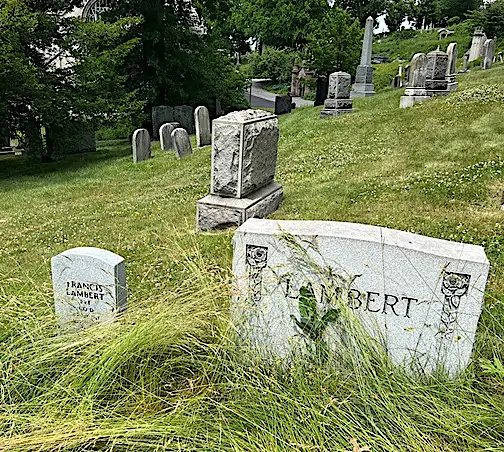
LAMBERT, HENRY (1835-1914). Private, 103rd New York Infantry, Company D. Born in Ireland, he enlisted at New York City on April 16, 1864, and mustered into the 103rd that day. He was confined on August 31, 1864, at Washington, D.C., and was absent when his company mustered out on December 7, 1865, at City Point, Virginia. His last residence was in Manhattan. His death was attributed to pneumonia. Section 148, lot 22406, grave 3.
LAMBERT, SAMUEL (1837-1863). Corporal, 70th New York Infantry, Company F. A native of England, he enlisted as a private at Port Jervis, New York, on April 20, 1861, and mustered into the 70th on June 20. At some point, he was promoted to corporal. After being wounded during the Battle of Gettysburg, Pennsylvania, on July 2, 1863, he succumbed to his wounds on July 21, and was originally buried at the Gettysburg National Cemetery, Gravesite D-49. On March 28, 1904, he was interred at Green-Wood. Section 195, lot 27553.
LAMBERT, WILLIAM (1843-1909). Private, 7th Regiment, New York State Militia, Company D. Lambert, who was born in New York City, enlisted as a private on April 26, 1861, and immediately mustered into the 7th Regiment. He served with the 7th Regiment for 30 days and mustered out with his company. In 1863, he returned to the same regiment and company, now part of the New York State National Guard, served for 30 days, and was discharged on July 20, 1863. In 1908, he received a pension, certificate 1,151,748. He last lived at 50 Central Park West in Manhattan. Lambert succumbed to nephritis. Section K, lot 17634.
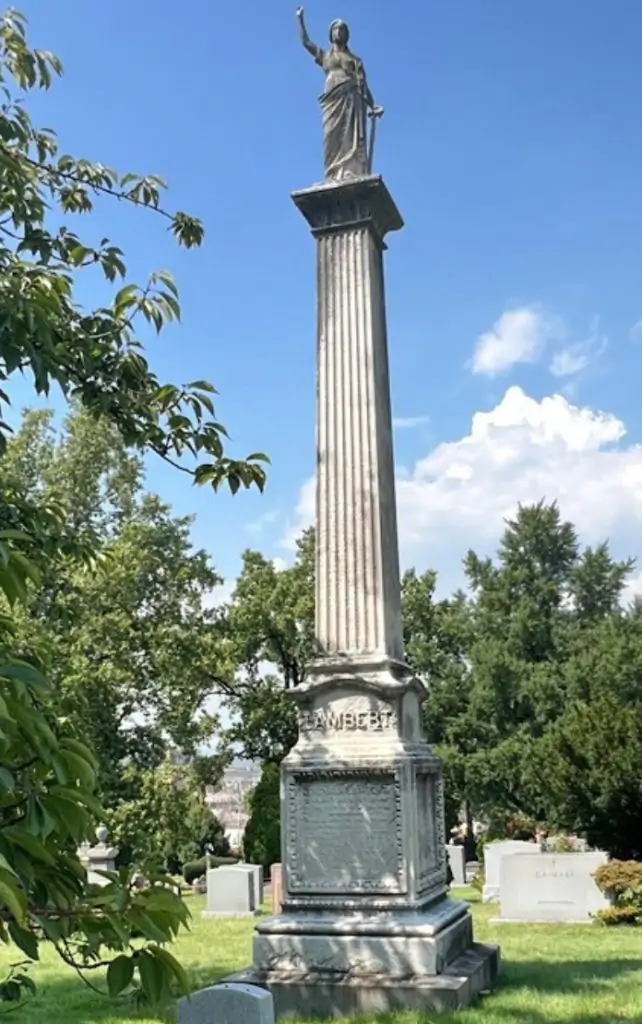
LAMBERTSON, JEREMIAH (or JENKINS) (1829-1897). Private, 1st United States Engineers, Company B. Lambertson served as a private in the 1st United States Engineers. Further details about his service are unknown. He last lived at 218 Dean Street in Brooklyn. Heart disease was the cause of his death. Section 134, lot 29725, grave 331.
LAMOREAUX, GEORGE W. (1824-1889). Third lieutenant, United States Revenue Marines. Born in New York, he was appointed as a third lieutenant in the Revenue Marine Service on March 26, 1862. No further record of his service can be found. His last residence was at 132 Clymer Street in Brooklyn. Heart disease was the cause of his death. Section 66, lot 1741.
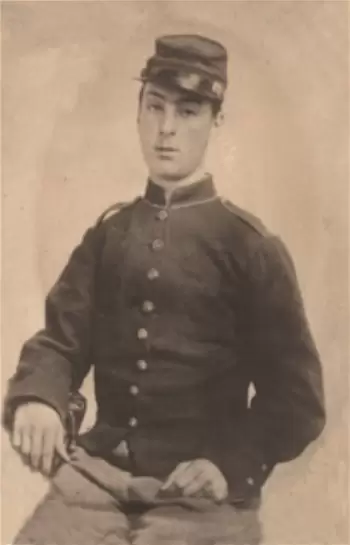
LAMY, ANDREW B. (1843-1862). Private, 51st New York Infantry, Company G. After Lamy, a native New Yorker, enlisted on September 10, 1861, at Brooklyn, he mustered into the 51st two days later. He was severely wounded in the right arm on March 14, 1862, at New Berne, North Carolina, necessitating an amputation, and died there of his wounds on April 6 (although one soldier document says April 15). The details of his medical history were recorded in The Boston Medical and Surgical Journal (Volume LXVI) edited by F. E. Oliver, M.D. and S. L. Abbot, M.D. (1862, p. 237). The report is printed below. As per his obituary in the Brooklyn Daily Eagle, which confirmed his death in battle, his remains were taken to the “Nathan Bangs” Church on Clove Road, near Butler Street, before his interment. He was interred at Green-Wood on May 11, 1862. In 1880, his mother, Emma Lamy, received a survivor’s pension, certificate 285,850. Section 65, lot 6081.
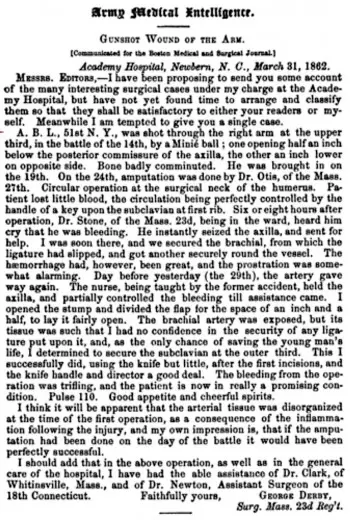
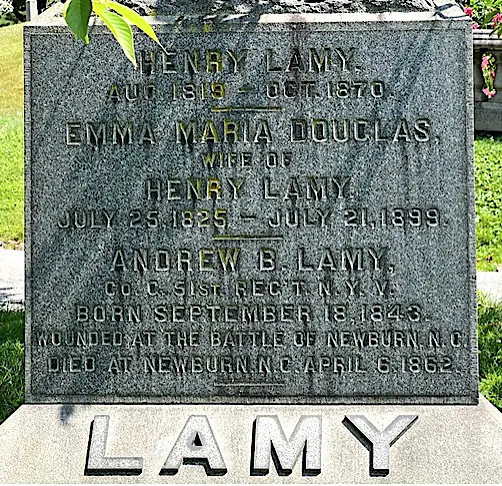
LANCEY, WILLIAM J. (1841-1898). Ordinary seaman, United States Navy. Lancey enlisted in the United States Navy in December 1863, served on the USS Georgia, and was discharged in August 1865 at New York City. He applied for a pension in 1891 and his widow, Margaret Lancey, who is interred with him, applied after his death in 1898. His last residence was at 197 18th Street in Brooklyn. Section 134, lot 29725, grave 458.
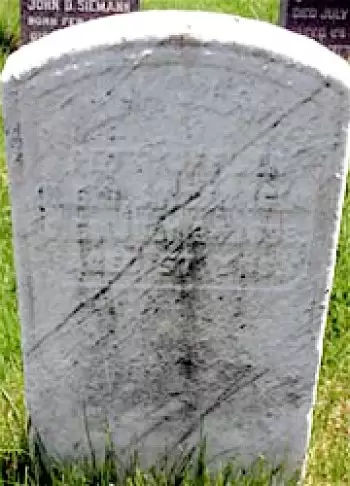
LANDERS, JOHN (1845-1892). Sergeant, Pennsylvania Independent Infantry. He enlisted as a sergeant on September 4, 1862, mustered into Company “James” of the Pennsylvania Independent Infantry, and was discharged on June 7, 1865. In 1891, he applied for an invalid pension that was granted under certificate 781,416. He last resided at 261 West 118th Street, New York City. Pauline S. Landers, who is interred with him, applied for and received a widow’s pension in 1892, certificate 375,260. Section 114, lot 16911.
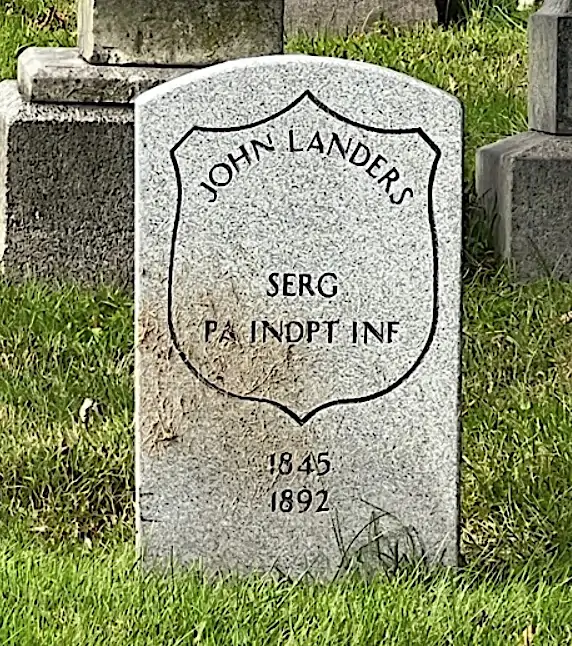
LANE, GEORGE F. (1831-1888). Private, 127th New York Infantry, Company K. After enlisting at Riverhead, New York, on August 23, 1862, he mustered into the 127th New York the next month on September 8. When his company mustered out on June 30, 1865, at Charleston, South Carolina, he was absent and hospitalized. His last residence was 150 South Portland Avenue, Brooklyn. Section 21, lot 10166.
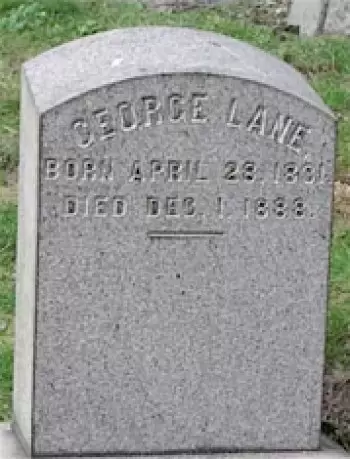
LANE, GEORGE W. (1827-1883). Private, 174th New York Infantry, Company B. Lane, a native Brooklynite, enlisted at New York City on October 6, 1862, and mustered into the 174th New York on October 17. No other information on his military service is available. He died at the Charity Hospital in New York City. Section 86, lot 1899.
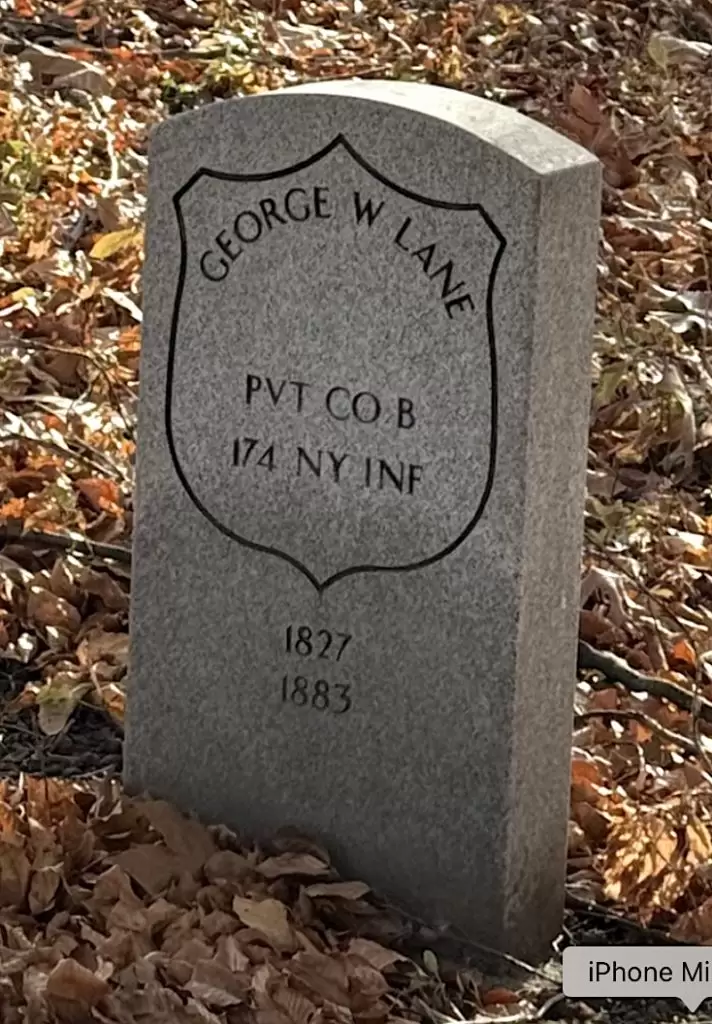
LANE, WILLIAM BLYTHE (1839-1911). Assistant surgeon, United States Army. Born in Cranbury, New Jersey, Lane was christened at the Second Presbyterian Church in Cranbury, New Jersey, on July 1, 1839. His parents were of Holland Dutch ancestry. The 1850 census notes that he lived with his parents and two younger siblings in South Brunswick, New Jersey. At the time of the 1860 census, he lived in Princeton, New Jersey, where he was attending Princeton College. As per his obituary in the Brooklyn Daily Eagle, he graduated from Princeton in 1861 and then entered Bellevue Medical College of New York, from which he was graduated in the spring of 1864. On July 22, 1863, he married Sarah Jewell Ward in Mercer, New Jersey; she died in 1877.
Upon graduation from medical school, as per his obituary, he entered the United States Army during the Civil War as an assistant surgeon. Stationed at the Army Hospital at Newark, New Jersey he cared for a large number of sick and wounded troops. In early May 1864, he was present at the Battle of the Wilderness, Virginia,
After tendering his resignation at the end of the Civil War, he established a medical practice in Philadelphia. The 1870 census reports that Lane was a physician in Philadelphia. He owned his own home, valued at $4,500, was married and had one child.
Lane’s interests turned to life insurance and his obituary reports that in December 1872, was appointed to a special office in the Manhattan Life Insurance Company of New York. In 1887, he became manager of agents, then rose to second vice president of the company in 1901. Lane became vice president of the company in 1905 and held that position until 1910, when he resigned because of health reasons. The 1910 census lists him as a physician who was married to Sarah Wiley in 1882, living at 395 Washington Avenue with his wife (nineteen years his junior) and two daughters (one from his first marriage), his father-in-law and two servants. According to the 1910 census, he lived at 395 Washington Avenue in a mortgaged home with his wife of 27 years, 36-year-old adult daughter and two servants. He was listed as a wage earner and office-president.
The Brooklyn Daily Eagle reports that Lane belonged to the Medical Society of the Kings County, the New York State Medical Society, was a vestryman of the Church of the Messiah, a trustee of the Franklin Trust Company of New York, and a director of the Manhattan Life Insurance Company of New York. That obituary concluded, “Dr. Lane was a man of sterling integrity, uprightness of purpose and beloved by all who knew him.” He was survived by two children from his marriage to Sarah Ward and one daughter from his second marriage to Sarah Thorne Wiley of Utica, New York. His death certificate states that he last lived in Brooklyn and was a physician. Lane’s last residence was at 395 Washington Avenue where he succumbed after a prolonged illness. Section 147, lot 33654.
LANGBEIN, CHRISTOPHER (1839-1910). Unknown soldier history. Originally from Germany, Langbein’s military record is unknown. His gravestone identifies him as having served during the Civil War. He last resided in Belleville, New Jersey. Section 140, lot 23479.
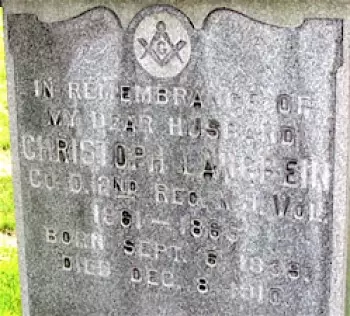
LANGDON, CHARLES SEAMAN (1836-1900). Major by brevet; captain, United States Volunteers Commissary Department. A Brooklynite by birth, Langdon enlisted as a captain on November 26, 1862, and was commissioned into the United States Volunteers Commissary Department at that time. He was subsequently promoted to major by brevet on March 13, 1865. He mustered out on April 30, 1866. His pension record indicates that he also served in the 55th New York Infantry but there are no further details. His last residence was 220 West 138th Street in Manhattan. Henrietta Langdon, his widow, sought a pension in 1920, application 1,164,208, but there is no certification number. Section 196, lot 30547.
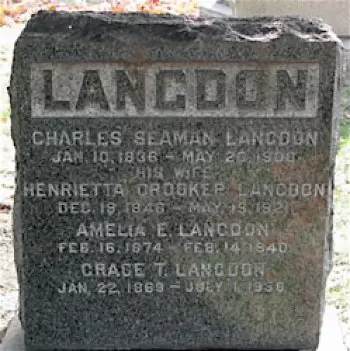
LANGDON (or LANDON), ISRAEL (or IRAD) CHARLES (1839-1900). Corporal, 69thPennsylvania Infantry, Company G; private, 71st Pennsylvania Infantry, Company G. Born in Pennsylvania, Langdon enlisted as a private on May 28, 1861, mustered immediately into the 71st Pennsylvania, and was transferred into the 69th Pennsylvania on February 24, 1864. He was promoted to corporal on January 6, 1865, and mustered out on July 1 of that year at Ball’s Cross Roads, Virginia. He applied for an invalid pension in 1867 that was granted, certificate 84,397.
His obituary in the Brooklyn Daily Eagle, which outlined his Civil War service, noted that he was a Unites States customs inspector for twenty-five years and a Brooklyn resident for thirty years. The obituary also reported that he had worked in New York City theaters prior to working for the government. He belonged to the Rankin Post #10 of the G.A.R. and the War Veterans and Sons’ Association; members of both groups were invited to attend his funeral. His last address was 2 St. Felix Street in Brooklyn. Upon his death in 1900, Rebecca J. Langdon, applied for and received a widow’s pension, certificate 504,660. Section 136, lot 28307, grave 4.
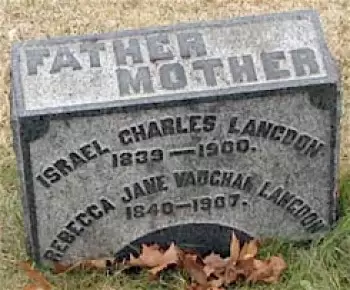
LANGFORD, EDWARD L. (1837-1902). First lieutenant, 7th Massachusetts Infantry, Companies A and B. A native and resident of Fall River, Massachusetts, Langford was an engraver by occupation when he enlisted as a first sergeant on April 16, 1861, and mustered into Company A of the 7th Massachusetts on June 15. At some point, he was promoted to sergeant major, and then became a second lieutenant on November 8, 1861. When he was promoted to first lieutenant on October 25, 1862, he was transferred to Company B. He mustered out on June 27, 1864, at Taunton, Massachusetts. He is listed in the 1890 Brooklyn Veterans Census. At the time of his death, he resided in Brooklyn. Section 147, lot 21474, grave 1718.
LANGLEY, THOMAS JAMES (enlisted as LANIGAN, THOMAS J.) (1842-1870). Private, 82nd New York Infantry, Company B. Langley, who was born in New York State, used the alias Thomas Lanigan when he enlisted as a private at New York City on April 17, 1861. He mustered into his company on May 11, was taken as a prisoner of war at the Battle of Bull Run, Virginia, on July 21, 1861, and subsequently paroled. He was discharged for disability on February 13, 1863, at Alexandria, Virginia. Langley last resided in Yonkers, New York. In 1873, his wife, Margaret, who is interred with him, applied for and received a widow’s pension, certificate 182,196. His remains were moved to the current location on September 17, 1887. Section 184, lot 25873.
LANGLEY, WILLIAM A. (1839-1891). Private, 84th New York (14th Brooklyn) Infantry, Company E; 5th New York Veteran Infantry, Company I. After enlisting on September 3, 1862, and mustering into the 14th Brooklyn the next day, he was later transferred to the 5th New York Veteran Infantry on June 18, 1864. Section 135, lot 27263, grave 2004.
LANIER, JAMES FRANKLIN DOUGHTY (1800-1881). Financier. Lanier was born in Beaufort County, North Carolina. As per his biography in the Dictionary of North Carolina Biography, edited by William S. Powell, his paternal ancestry traced a common ancestor with George Washington. That source also reports that his grandfather, James Lanier, was a captain in a light cavalry regiment in the American Revolution and later served under General Anthony Wayne in a campaign against Indians in the Northwest Territory. That article also notes that James’s father, Alexander Lanier, emancipated his two enslaved people in 1807 when the family moved to Ohio. The family then moved to Madison, Indiana, in 1817, where Alexander owned a dry goods store; in 1820, Alexander died, leaving debts that James eventually repaid. In 1819, James married Elizabeth Gardner in Madison, Indiana; they had eight children.
James Lanier studied law at Transylvania University, then served as the assistant clerk and later chief clerk of the Kentucky House of Representatives. He was the first president of the Madison, Kentucky, branch of the Indiana State Bank, and a federal pension agent for the Northwest. He represented Indiana at a meeting with European creditors and helped negotiate a deal that saved the state from bankruptcy. His first wife died in 1846; he then married Mary McClure in 1848; they had three children.
In 1849 he came to New York City, where he lived at 16 West 10th Street, and founded Winslow, Lanier & Company, which specialized in railroad bond issues. It was not uncommon for his firm to handle $1 million per day in these securities. He later successfully managed the Pittsburgh, Ft. Wayne, & Chicago Railroad. His financial skills allowed him to repeatedly save the state of Indiana from bankruptcy, particularly during the Civil War.
When the Civil War began, Lanier loaned the governor of Indiana $400,000, which allowed that state to equip its troops and send them off to fight for the Union. In 1862, when Indiana again faced a financial crisis, Lanier advanced $640,000 to save the day; the state repaid him in 1870. His Greek Revival mansion, completed in 1844 in Madison, Indiana, overlooking the Ohio River, survives and is open to the public as the James F.D. Lanier State Historic Site. As per Wikipedia, the state of Indiana preserved his residence in gratitude for his financial help. Section 98, lot 7131.
LANKENAU (or LANKENAN), WILLIAM (1825?-1896). Second lieutenant, 158th New York Infantry, Companies G and I. Lankenau was born in Germany. The 1855 New York State census reports that he was living in Brooklyn with his wife Margaret, an infant daughter, his mother and his 17-year-old sister. That census suggests a birth year of about 1825 which is what his soldier records confirm; the Green-Wood database suggests that he was born in 1837. Being that there is only one soldier with his name in the entire Union Army of over three million, the man interred at Green-Wood is likely the soldier. As per the 1862 Brooklyn Directory, Lankenau was a merchant. The 1863 Brooklyn Directory notes that he was living at 431 West 82nd Street in New York City.
His soldier record, which uses the name Lankenan, shows that he enlisted as a corporal at Brooklyn on August 22, 1862, and mustered into Company G of the 158th New York Infantry six days later. He was promoted to sergeant on January 13, 1863, and then to second lieutenant on February 25, 1865, with rank from February 18. His muster roll notes that he was transferred into Company I of the 158th Infantry on March 17, 1865. He was listed as present on the muster rolls in April 1865. He was discharged with his company on June 30, 1865, at Richmond, Virginia.
At the time of the 1872 New York City Directory, Lankenau was living at 108 Greenwich Street and working as a carpenter. The 1891 New York City Directory indicates that was living at 533 West 30th Street and was employed as a grocer. He last lived at 529 West 30th Street in New York City. His death was attributed to cancer. Section 203, lot 25925, grave 3.
LANNING, RALPH AUGUSTUS (1835-1893). Captain, 83rd New York Infantry, Company D. A merchant, 5′ 8″ tall with dark complexion and brown eyes, Lanning enlisted as a sergeant at New York City on May 27, 1861, and mustered in on that date. He was promoted to first lieutenant on January 17, 1862, and to captain on May 22, 1862. On September 17, 1862, at Antietam, Maryland, while leading his company, he was shot by a musket ball through the right calf and injured by a piece of shell in the left hip. He was treated at a private house near the battlefield and discharged for disability on December 11, 1862. He returned home to Brooklyn on crutches, and remained disabled throughout his life, although he continued to work as a merchant. Lanning applied for and received an invalid pension in 1879, certificate 196,796. He resided at 608 Fourth Avenue in the Park Slope section of Brooklyn at the time of his death. Julia Lanning, who is interred with him, applied for and received a widow’s pension in 1893, certificate 390,700. Section 199, lot 24992.
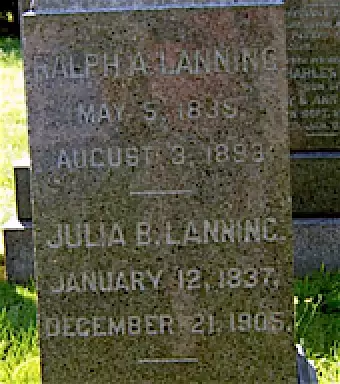
LAPPIN, EDWARD (1843-1917). Corporal, 53rd New York Infantry, Company B. A native New Yorker, he enlisted as a private at New York City on September 16, 1861, immediately mustered into the 53rd New York, was promoted to corporal during his service, and mustered out on March 21, 1862, at Washington, D.C. He last lived in Jersey City, New Jersey. Section 86, lot 3330, grave 15.
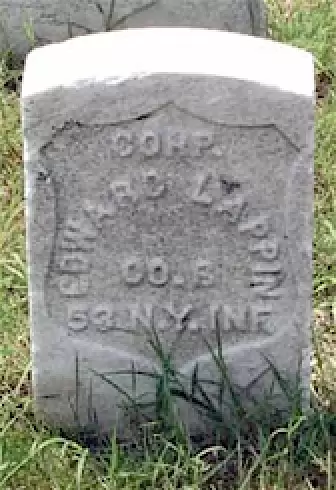
LARCOMBE, ALBERT (1848-1930). Rank unknown, Morgan’s Cavalry Brigade, Confederate States of America. Larcombe, a native of Philadelphia, Pennsylvania, was raised in Nashville, Tennessee. During the Civil War, he served with Morgan’s Cavalry Brigade, familiarly known as Morgan’s Raiders, a Confederate Regiment. As per his obituary in the Brooklyn Daily Eagle, he enlisted with Morgan’s raiders at the onset of the Civil War and remained with that outfit throughout the conflict. His obituary notes that he had a saber scar on his left arm received while saving Morgan’s life during a skirmish with Federal Cavalry.
After the War, Larcombe hiked across the country to California, took to sea and made several trips around the world before settling in New York. He then became manager of Alfred D. Beeken, Inc., a printing concern at 122 Chambers Street in Manhattan, and served with that firm for more than 20 years. In 1925, he and his wife, Florence, celebrated their golden (fifty years) wedding anniversary. Active in religious life, he taught Sunday school at the Washington Avenue Baptist Church to which he belonged for 30 years. For the last two years of his life, he belonged to the Hanson Place Baptist Church where his funeral was held. He last lived at 88 Madison Street in Brooklyn. Section 65, lot 4744.
LARGE, THOMAS (1842-1908). Private, 1st New York Cavalry, Company M. Large was born in England. During the Civil War, he enlisted as a private on September 4, 1861, and mustered into Company M of the 1st New York Cavalry. Large was captured at Fredericksburg, Virginia, on September 13, 1862, and paroled at Blue Ridge, Mountain, Virginia, the next day. The expiration of his service is uncertain. Although one record notes that Large mustered out on January 1, 1864, at Charlestown, Virginia, another record indicates that he deserted on that date. The 1890 Veterans Schedule, which confirms his Civil War service, indicates that he served for one year and four months, an unusual deployment, and further states that he was held at Libby Prison and that his papers had been “mislaid.”
The 1870 census shows that Large lived in Manhattan and was a stage driver. Large mustered into the James S. Wadsworth Post #77 of the G.A.R. on May 25, 1878; he listed his occupation as driver. As per his death certificate, he was a widower who worked as a driver. He last lived at 432 East 66th Street in Manhattan. His death was attributed to pneumonia. Section 15, lot 17263, grave 1856.
LARK, PETER D. (1840-1899). Private, United States Army Engineer Corps, Company A. On October 10, 1860, Lark enlisted and mustered into Company A of United States Engineers. He re-enlisted on July 11, 1864 (re-enlistment credited to Boston, Massachusetts), and was discharged at West Point on July 11, 1867. He received a pension although there are no details. In 1893, he became a stableman at Green-Wood Cemetery and subsequently became a member of the Green-Wood police force which was dedicated to preventing crime and keeping order on the cemetery grounds. He was the captain of the twelve man force, a position that paid $70 a month and came with a small cottage on the grounds at 23rd Street and Seventh Avenue and free coal and gas.
According to an article in the Brooklyn Brownstoner, Lark lived in the house with his much younger second wife, the daughter of a Green-Wood stableman, James Snell. The article went on to state that Peter Lark drank heavily and abused his young bride at which time she would leave and go to her mother’s nearby home before returning to live with him. After her mother died in February 1899, she would run to her brother’s house when she was beaten but again, would not let her family interfere in her domestic troubles. On the morning of March 5, 1899, Peter Lark failed to report on his nightly tour of the cemetery, a daily routine that he always handled. After his son summoned him to the kitchen for breakfast, all he heard was a single gunshot. Charles Lark ran to summon his step-uncle who refused to come with him to the house, then ran to another nearby relative who, upon reaching the cottage, found that Peter Lark had committed suicide with a gunshot to the head above his right ear. Section 197a, lot 29624.
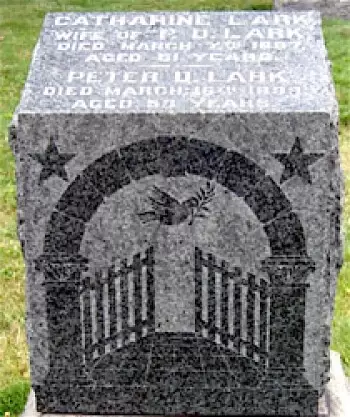
LaROSA (or LaROZA), GEORGE WASHINGTON (1833-1916). Second lieutenant, 133rd New York Infantry, Company G. After he enlisted as a sergeant on August 30, 1862, he mustered into the 133rd New York on September 24, 1862, was commissioned as second lieutenant on August 10, 1863, and was discharged for disability on January 8, 1865. He lived in Mamaroneck, New York, at the time of his death. Section 143, lot 22221.
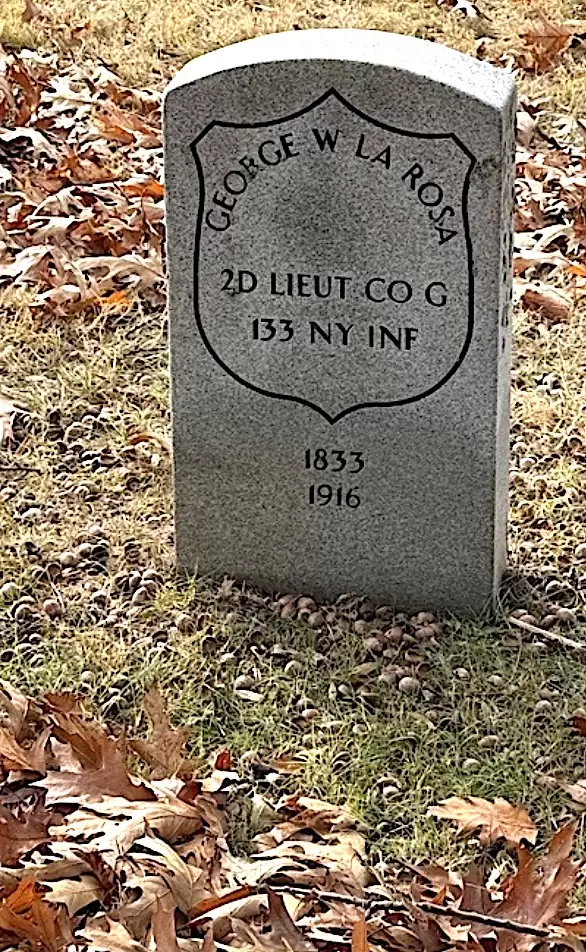
LARSEN, LARS (1813-1907). Gunner, United States Navy. Born in Copenhagen, Denmark, Larsen came to the United States in 1832 and joined the merchant service. In 1834, he enlisted in the Navy and later served as a seaman during the Mexican War. In addition, he served on board the USS Constitution as a gunner. He served in the United States Navy for 23 years and left the service on June 17, 1869. In November 1869 when he applied for a Navy invalid pension, he listed his occupation as quarter gunner and was 5’7½” tall with dark hair and fair complexion. Larsen noted that he had impaired eyesight and poor teeth making it difficult to see or eat. He received a pension, certificate 1,343. When he died at age 94, he resided at 237 53rd Street, Brooklyn. Section 200, lot 23646, graves 1 and 2.
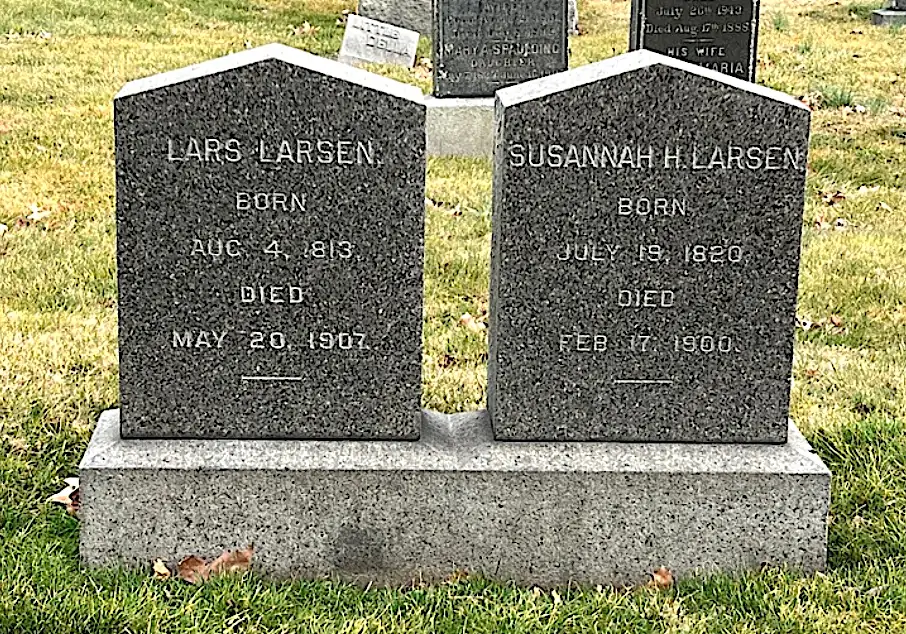
LARSON (or LARSEN), EDWARD M. (1847-1906). Seaman, United States Navy. Of Norwegian origin, he enlisted in the United States Navy on February 7, 1865, at New York City, and was discharged there on August 16, 1866. He last lived at 79 West 102nd Street in Manhattan. Section 85, lot 32200, grave 37.
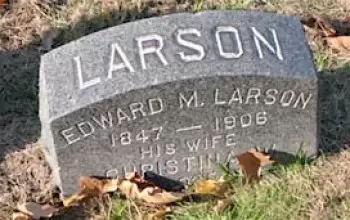
LaRUE, ISAAC C. (1820-1872). Sergeant, 12th Regiment, New York State National Guard, Company A. A native New Yorker, LaRue enlisted as a sergeant at New York City on May 31, 1862, the same date that he mustered into the 12th Regiment when it was activated that year for three months. He mustered out with his company at New York City on October 8, 1862. His last address was 306 West 11th Street in Manhattan. Section 102, lot 8375.
LAST, EDWARD (enlisted as EDWARD JOHNSON) (1834-1898). Seaman, United States Navy. Of German origin and borne on the rolls as Edward Johnson, he was a seaman onboard the USS North Carolina and the USS Sabine during the Civil War. He was awarded a pension from the Navy. According to his death certificate, he was a sailor by occupation. He last lived at 100 Dwight Street in Brooklyn. After his death, Maria Last, who is interred with him, applied for and received a widow’s pension, certificate 17,682. Section 134, lot 29725, grave 54.
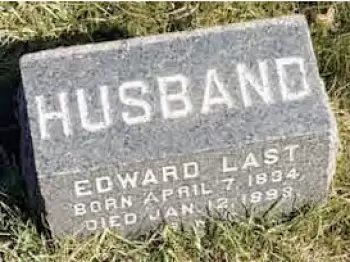
LATHROP, LUTHER A. (1832-1883). Corporal, 71st Regiment, New York State National Guard, Company D. Lathrop, who was born in Vermont, served in his unit for 30 days in 1863 as a corporal. According to his obituary in The New York Times, he was a member of the firm of Meyer & Lathrop, cigar-dealers in Manhattan, and died suddenly on Beekman Street in Manhattan of an apparent heart attack. He last lived at 103 North Portland Avenue, Brooklyn. Section 158, lot 17261.
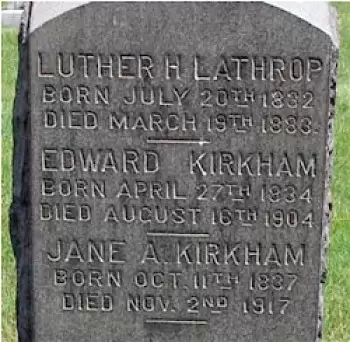
LATIMER, JOHN (1840-1888). Private, 84th New York (14th Brooklyn) Infantry, Company H. Born in Ireland, Latimer enlisted at Brooklyn as a private on April 18, 1861, mustered into the 14th Brooklyn on May 23, and deserted on September 26, 1861, at Arlington, Virginia. His last residence was 94 Adelphi Street in Brooklyn. Section 114, lot 8999, grave 263.
LATOUNT (or LECOUNT), WILLIAM (1829-1892). Private, 97th New York Infantry. He enlisted at Brooklyn on February 13, 1865 and mustered in on that date. He mustered out at Hart’s Island, New York Harbor, on May 5, 1865. His last residence was at 265 19th Street in Brooklyn. Section 85, lot 17700, grave 30.
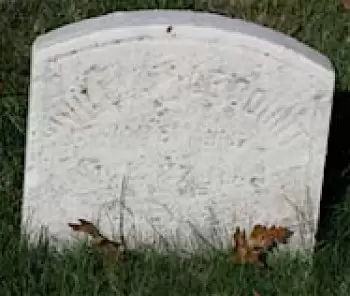
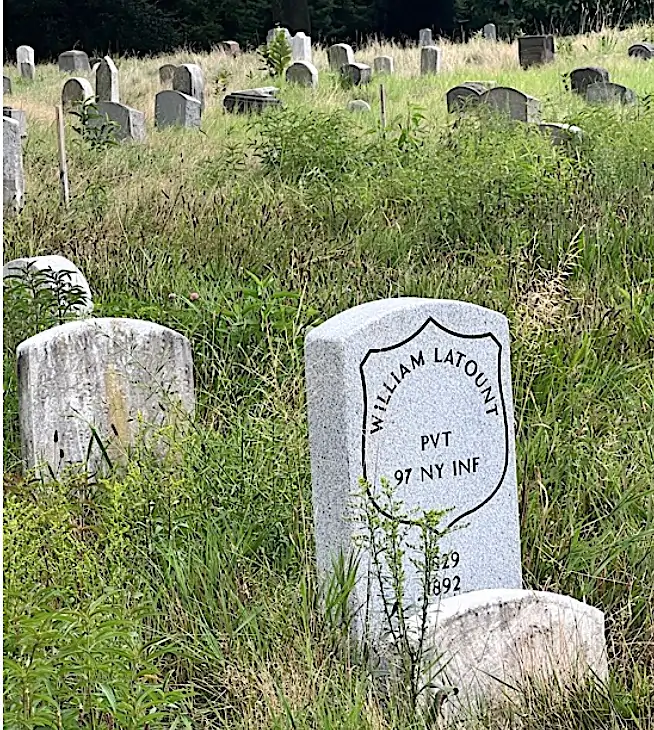
LATTLER, JOHN (1848-1894). Private, 38th Illinois Infantry, Company C. A resident of Mattoon, Illinois, he enlisted as a private in the 38th Illinois Infantry on May 12, 1864, and mustered in the next day. He mustered out on March 20, 1866, at Victoria, Texas. Section 135, lot 27263, grave 802.
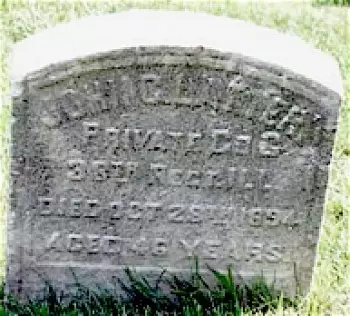
LAU (or LAW), JACOB HENRY (1836-1904). First lieutenant, 13th Regiment, New York State National Guard, Company K. A native of Germany, Lau enlisted at Brooklyn and was commissioned as a second lieutenant of Company K of the 13th New York State National Guard (Heavy Artillery) on May 28, 1862. He mustered out with his company on September 12, 1862, at Brooklyn. On June 20, 1863, he enrolled to serve 30 days, and on July 21, 1863, he was commissioned as a first lieutenant into Company K of the 13th New York National Guard, dating to June 20, then mustered out on that same day at Brooklyn. His last residence was in Manhattan. Section 176, lot 19956, grave 78.
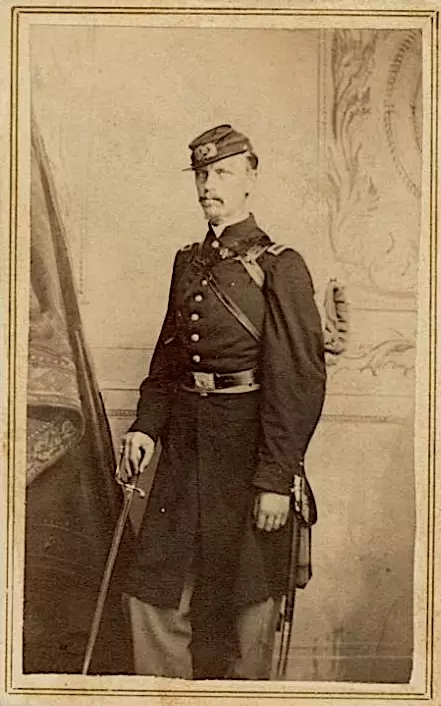
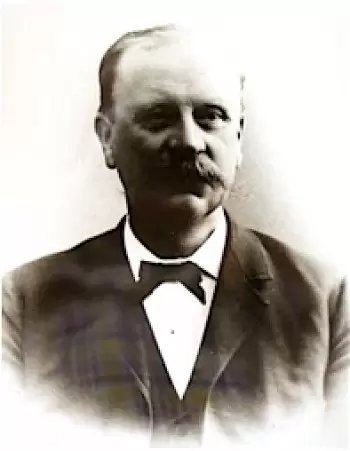
LAUBER, CHARLES (1840-1920). Private, 8th New York Infantry, Company G. Born in Germany, he enlisted on April 23, 1861, at New York City, mustered into the 8th New York that day, and deserted on July 26 of that year at Washington, D.C. In 1908, he applied for an invalid pension, application 1,374,419, but apparently no certificate was issued. As per his obituary in the Brooklyn Daily Eagle, he belonged to many organization including the Freemasons, Masonic Veterans, Order of the Eastern Star (a Masonic organization) and the Odd Fellows. His last residence was at 81 Pilling Street in Brooklyn. Section 173, lot 15160.
LAURIER, THEODORE (1838-1862). First lieutenant, 71st New York Infantry, Company K. A native of Scotland and resident of Congress Street in Brooklyn, Laurier enlisted as a first lieutenant at New York City on May 14, 1861, and was commissioned into the 71st New York on August 4 of that year. After being wounded at the Battle of Fair Oaks, Virginia, on June 1, 1862, he died of gangrene at Fortress Monroe on June 8. Brigadier General Daniel E. Sickles, commanding officer of the Second Brigade, wrote of the assault on the Richmond Stage Road in his field report of June 7 from Fair Oaks, “I have especially to regret…Lieutenant Laurier, commanding Company K, Second Regiment, who [was] seriously wounded, while bravely leading [his company] in a bayonet charge…” Interment at Green-Wood was on June 16; his remains were moved to their current location on August 29, 1862. There is a government-issued stone that was placed on his grave early in the 20th century. Section 115, lot 13536 (Soldiers’ Lot), grave 11.
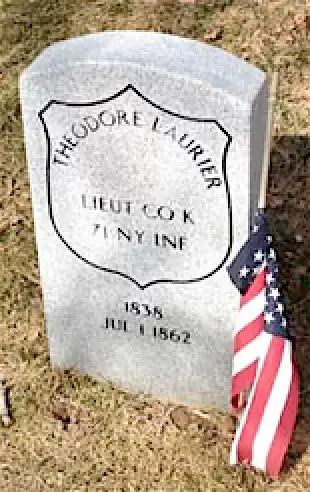
LAUTESCHLAGER, JULIUS (1840-1903). Private, 20th New York Infantry, Company E. Of German origin, Lauteschlager enlisted on May 3, 1861, at New York City, and mustered into the 20th New York three days later. Although it is stated that he deserted on August 20, 1861, this is apparently an error because his application for an invalid pension was approved in 1892, certificate 980,280. The pension record indicates that he also served in Company C of the 46th New York. His last address was 534 Third Avenue in Manhattan. Anna Lauteschlager, who is interred with him, applied for and received a widow’s pension upon his death in 1903, certificate 556,355. Section 128, lot 3262, grave 298.
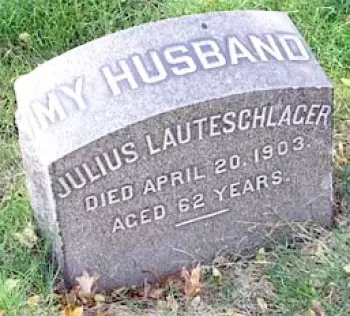
LAVELLE (or LOVELL), JAMES (1837-1914). Private, 11th New York Infantry, Company A. A native of Buffalo, New York, Lavelle enlisted at New York City on April 20, 1861, mustered in on May 7, and mustered out at New York City on June 2, 1862. He last resided at 206 Willoughby Avenue in Brooklyn. Section 5, lot 34091, grave 2.
LAVERTY, WILLIAM (1831-1881). Private, 15th New York Heavy Artillery, Company M. Originally from Ireland, Laverty enlisted as a private on January 14, 1864, at Copake, New York, mustered into the 15th New York Heavy Artillery the next day, and mustered out on August 22, 1865, at Washington, D.C. In 1880, he applied for and received an invalid pension, certificate 640,378. His last residence was 294 5th Street in Brooklyn. In 1899, his widow, Margaret Laverty, applied for and received a pension, certificate 492,152. Section 115, lot 4196, grave 859.
LAW, PATRICK (1822-1885). As per his Ancestry.com family tree, Patrick was born in Ireland. His death certificate notes that he lived in the United States for 43 years, implying that he immigrated in 1842. As per federal censuses, he was residing in New York City in 1850 and in Brooklyn in 1860. The online family tree reports that he was married to Margaret; they had a daughter, also named Margaret, who was born in 1855. As per the 1850 census, which confirms his Irish birth, he was living with his wife, listed as Matilda on the census, and a seven-year-old, Jane McGeer, relationship unknown.
According to his muster roll, Law enlisted on December 12, 1861, and mustered into Company F of the 1st New York Engineers as a private that same day. He was discharged for disability at Hilton Head, South Carolina, on October 1, 1862. His muster roll reports that he was also borne on the rolls as Patrick Lean.
The 1873 Brooklyn Directory lists Law as a laborer. As per the 1880 census, which lists his wife as Matileda (sic), he lived at 22 Fleet Place in Brooklyn, and was a store setter. He lived with his daughter Margaret, her husband, Gus Waldner (or Weldner), and their two-year-old daughter Mattilda.
His death certificate notes that Law was in the United States for 43 years, was married, last resided at the Fleet Street address, and was a mason by trade. His death was attributed to capillary bronchitis. Section ?, lot 5499, grave 1865.
LAWDER, JOHN (1846-1904). Private, 1st Maryland Cavalry, Company M. Lawder, who was born in England, defended the Union when he enlisted on March 1, 1864, and mustered into the 1st Maryland Cavalry. He mustered out on August 8, 1865. His last address was 297 10th Avenue in Manhattan. Section 17, lot 17245, grave 1792.
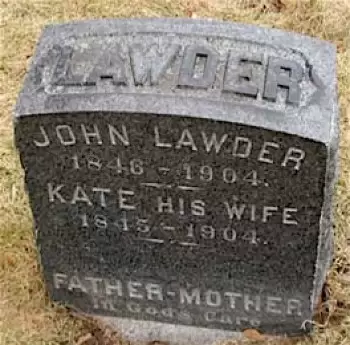
LAWRENCE, ALEXANDER (1827-1866). Private, 79th New York Infantry, Company I. Lawrence, who was born in New Jersey, enlisted on September 20, 1862, at New York City, as a private. After mustering into the 79th the same day, he mustered out on May 30, 1865. He last resided in New York where he succumbed to phthisis (tuberculosis). Section 59, lot 1529.
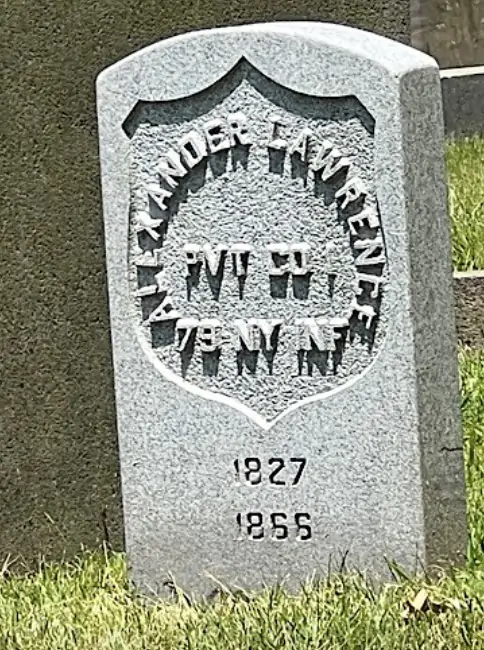
LAWRENCE, CHRISTIAN S. (1842-1901). Acting ensign, United States Navy. Lawrence enlisted in the United States Navy as a mate on April 4, 1862, was promoted to acting ensign on December 20, 1863, and honorably discharged on November 2, 1865. He returned to the Navy on December 6, 1866, as an acting ensign, and mustered out on August 24, 1868. He was a member of the George C. Strong Post #534 of the G.A.R. His last address was 95 Saratoga Avenue in Brooklyn. Section 170, lot 13490, grave 4.
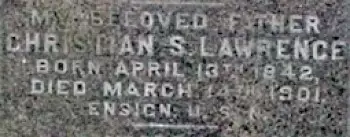
LAWRENCE, GILBERT S. (1844-1904). Corporal, 67th New York Infantry, Company F; first lieutenant, 7th New York Infantry, Company B. Born in Newtown, Long Island (now Queens), Lawrence enlisted as a private at Astoria, New York, on May 5, 1861, mustered into the 67th on June 20, was promoted to corporal on July 1, 1862, and was discharged for promotion on October 12 of that year. He re-enlisted seven days later as a first lieutenant at Key West, Florida, was commissioned into the 7th New York on January 15, 1863, and was dismissed a month later on February 18. He last lived at 58 Wardell Court in Long Island City. Section 60, lot 529, grave 6.
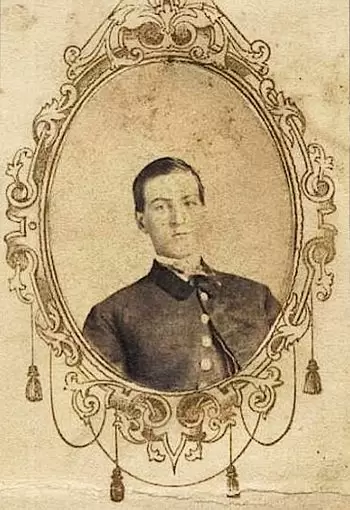
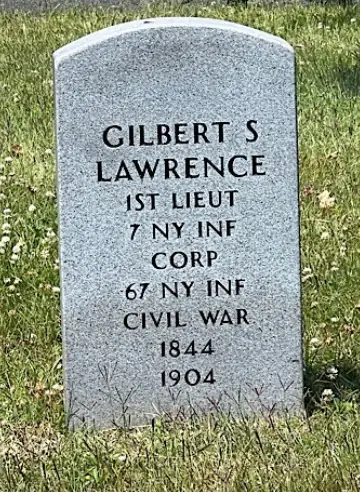
LAWRENCE, ISAAC M. (1842-1899). Corporal, 87th New York Infantry; 40th New York Infantry, Company H; private, 6th Veteran Reserve Corps, Company H. A native New Yorker, he enlisted as a private on October 8, 1861, and mustered into the 87th New York Infantry. On January 3, 1862, he was promoted to corporal. Later that year, he was transferred into the 40th New York Infantry on September 6. On March 20, 1864, he was again transferred, this time into the 6th Veteran Reserve Corps, Company H, and was reduced to the rank of private. He mustered out on October 25, 1864, at Washington, D.C. Lawrence last lived on 7th Avenue, New York City. Section 196, lot 28397, grave 2.
LAWRENCE, ISAAC SAVAGE (1843-1906). First sergeant, 80th New York Infantry, Company B. After enlisting as a private at Kingston, New York, on August 19, 1861, he mustered into the 80th New York the next month on September 5. On September 17, 1862, he was wounded on the battlefield at Antietam, Maryland, and was discharged for disability on March 1, 1863. He mustered into the same regiment and company on February 22, 1864, and rose through the ranks to corporal on July 2, 1864, to sergeant two months later on September 12, and to first sergeant on April 30, 1865. On October 10, 1865, he was discharged for disability.
Isabelle Pell Moore Lawrence, his wife, was the great-granddaughter of Colonel David Jones Pell, who in colonial times received the royal charter for Pelham, New York. She was active in many organizations including the D.A.R., of which she was a regent; the Daughters of 1812, where she was chaplain; the New York Founders and Patriots, on whose board she served; and the New Jersey Historical Society. Section 74, lot 32587.
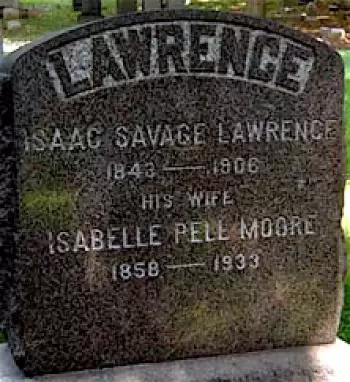
LAWRENCE, JOHN (1838-1896). Sergeant, 7th Regiment, New York State Militia, Company K. Lawrence served with the 7th Regiment for 30 days in 1861, and returned to the same company when the regiment was reactivated for three months in 1862 and was part of the New York State National Guard. After the Civil War, he was a member the G.A.R. veterans’ association as of December 1888. A resident of New York City, he died in Southampton, New York. Section 94, lot 11251.
LAWRENCE, JOSEPH (?-1861). Unknown soldier history. Lawrence died at the Battle of Big Bethel, Virginia, in June 1861. His death was noted by Joseph Woodward, who took a reporter from the Brooklyn Daily Eagle with him when he decorated the graves of the War dead in 1890. Further details of Lawrence’s service are not known. Section ?, lot ?.
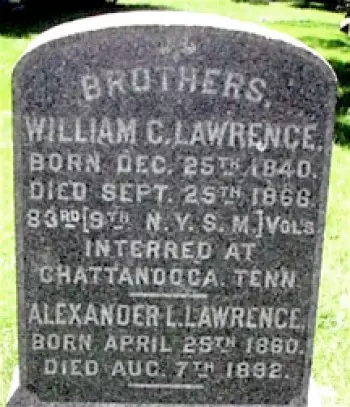
LAWRENCE, WILLIAM C. (1840-1866). Private, 83rd New York Infantry, Company A; Veteran Reserve Corps. Lawrence is not buried at Green-Wood; the cenotaph that bears his name honors his memory and service. Lawrence enlisted at New York City on May 27, 1861, and mustered in on that date. He was wounded at the Battle of Second Bull Run, Virginia, on August 30, 1862, and transferred into the Veteran Reserve Corps on February 16, 1864. A cenotaph lists both William Lawrence and his brother Alexander, and indicates Lawrence died on September 25, 1866, and was interred at Chattanooga, Tennessee. The granite monument also validates William Lawrence’s service in the 83rd New York and its connection to the 9th New York State Militia. Section 170, lot 13490.
LAYTON, JOHN W. (1824-1898). Private, 84th New York (14th Brooklyn) Infantry, Company B; 5th New York Veteran Infantry, Company I. Enlisting on August 21, 1862, at Brooklyn, the native New Yorker mustered into the 14th the next day. On June 2, 1864, he was transferred into the 5th Veteran Infantry and on that date was wounded at Cold Harbor, Virginia. On August 21, 1865, he was absent and sick at his mustering out at Hart’s Island, New York Harbor. Layton applied for an invalid pension in 1878 that was granted under certificate 692,357. He last resided in Brooklyn. Rebecca Layton, his widow, applied for a pension in 1898 that she received under certificate 466,333. Section 44, lot 6272, grave 2.
LAYTON, WILLIAM (1831-1888). Sergeant, 59th New York Infantry, Company A. Born in England, he enlisted on July 28, 1861, at New York City, and mustered in on August 2. He was promoted to sergeant on September 17, 1862, and was discharged for disability on February 19, 1863, at Falmouth, Virginia. He last lived at 52 Willoughby Street in Brooklyn. Section 44, lot 6272.
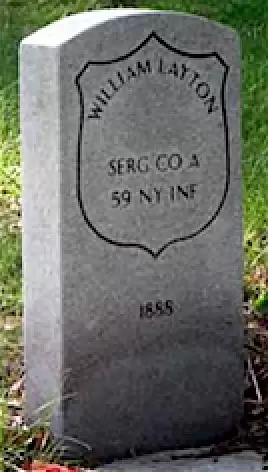
LEACH, LAWRENCE L. (1839-1905). Artificer, 15th New York Engineers, Company A. A native of New York, Leach enlisted as a private at Willets Point, New York, on May 9, 1861, and mustered into the 15th Engineers on June 17. At some point, he was promoted to artificer. Leach was paid $14.30 per month by the State of New York. He mustered out with his company on June 25, 1863, at New York City.
The 1872 New York City Directory lists Leach as a laborer living at 147 Christopher Street. At the time he mustered into the James S. Wadsworth Post #77 of the G.A.R. on April 9, 1881, he was a tinsmith living in New York City. The 1890 Veterans Census confirms his Civil War service as a “U.S. Soldier.” Leach is listed as a laborer in the 1890 Brooklyn Directory and a watchman in the 1901 Brooklyn Directory; he was living at 167 22nd Street in both directories. In 1903, he applied for and received a pension, certificate 1,069,506. His last address was 167 22nd Street in Brooklyn. His death was attributed to rheumatism. Although his wife applied for a widow’s pension, application 827,136, there is no evidence that it was certified. Section 86, lot 31217, grave 204.
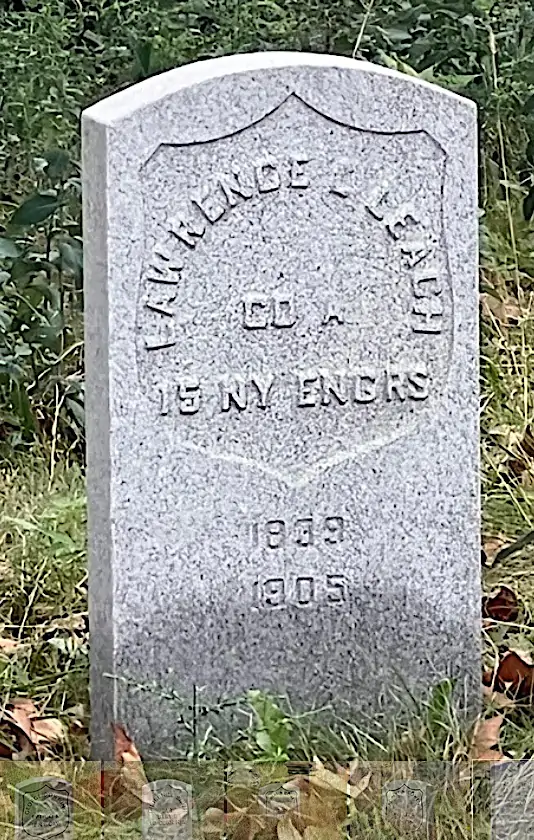
LEARMONTH (or LARMOUTH), WILLIAM (1839-1891). Private, 11th New York Cavalry, Companies B and D. Of Irish origin, Learmonth enlisted as a private at New York City on January 25, 1862, and mustered into Company B of the 11th New York Cavalry three days later. He re-enlisted on February 3, 1864, and transferred within the regiment to Company D on July 21, 1865, before he mustered out on September 30, 1865, at Memphis, Tennessee. In 1885, his application for an invalid pension was granted, certificate 442,663. At the time of his death, he lived at 145 Navy Street in Brooklyn. Mary Learmonth applied for and received a widow’s pension in 1892, certificate 342,364. Section 135, lot 27263, grave 368.
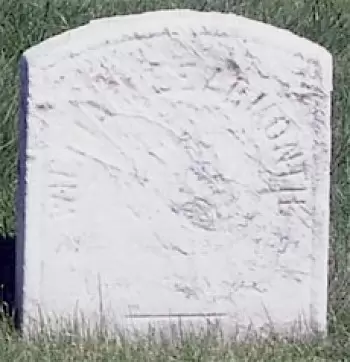
LEARY, JAMES M. (1833-1898). Second lieutenant, 11th New York Infantry, Company E. A native New Yorker, he enlisted as a sergeant at New York City on April 20, 1861, and mustered into the 11th New York on May 7. On July 21, 1861, he was wounded and captured in combat at Bull Run, Virginia, and released on January 18, 1862. He was promoted to second lieutenant on February 15, 1862, and mustered out on June 2 at New York City. In 1891, he applied for and received an invalid pension, certificate 190,772. Leary last lived at 28 West 116th Street in Manhattan. His widow, Annie Leary, applied for and received a pension in 1898, certificate 659,029. Section 62, lot 2223.
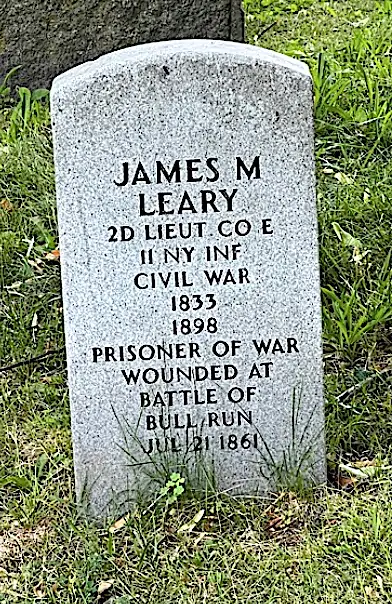
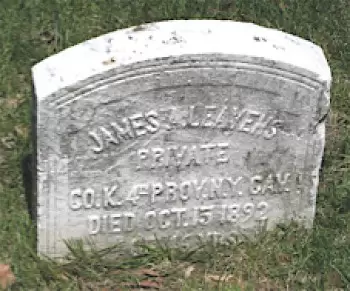
LEAVENS (or LEAVINS), JAMES A. (1846-1892). Private, 1st New York Mounted Rifles, Company K; 4th Provisional Cavalry. Of English origin, Leavens enlisted on January 11, 1864, at New York City, and mustered into the 1st Mounted Rifles on January 17. On September 6, 1865, he transferred into the 4th Provisional Cavalry and mustered out at City Point, Virginia, on November 29, 1865. His last residence was at 210 Prospect Street in Brooklyn. He died from a pistol shot wound. Section 182, lot 11864.
LEAVENWORTH, MARK FREDERICK (1832-1864). Captain, 18th Infantry, United States Army; first lieutenant, 3rd Cavalry, United States Army. A native of Bennington, Vermont, Leavenworth was a cadet at the United States Military Academy at West Point from September 1, 1849 through June 24, 1850. According to the census of 1860, he was living in New York City with his family and working as a merchant. During the Civil War, he enlisted as a first lieutenant on May 14, 1861, and was immediately commissioned into the 3rd Cavalry, United States Army. He was discharged on August 6, 1861, at the expiration of his appointment. (Note: The “Vermont in the Civil War” database incorrectly lists his service in the 7th Cavalry.) Leavenworth re-enlisted as a captain on February 19, 1862, and was commissioned into the 18th Infantry, United States Army. On August 12, 1862, he wrote a letter to the adjutant general in response to charges brought against him for drinking while on duty. In his defense, he admitted to drinking when the new sutler opened his establishment but denied knowing that he was on duty and claimed that the colonel considered the men under him “his body guard,” and was held up to ridicule. Leavenworth also blamed weeks under the broiling sun with no shade as factors in his “inexcusable” drinking. He further stated that the charges were brought by a man who had been reduced to ranks for insubordination. He resigned on April 27, 1863. Leavenworth died in Tennessee. Section 108, lot 71.
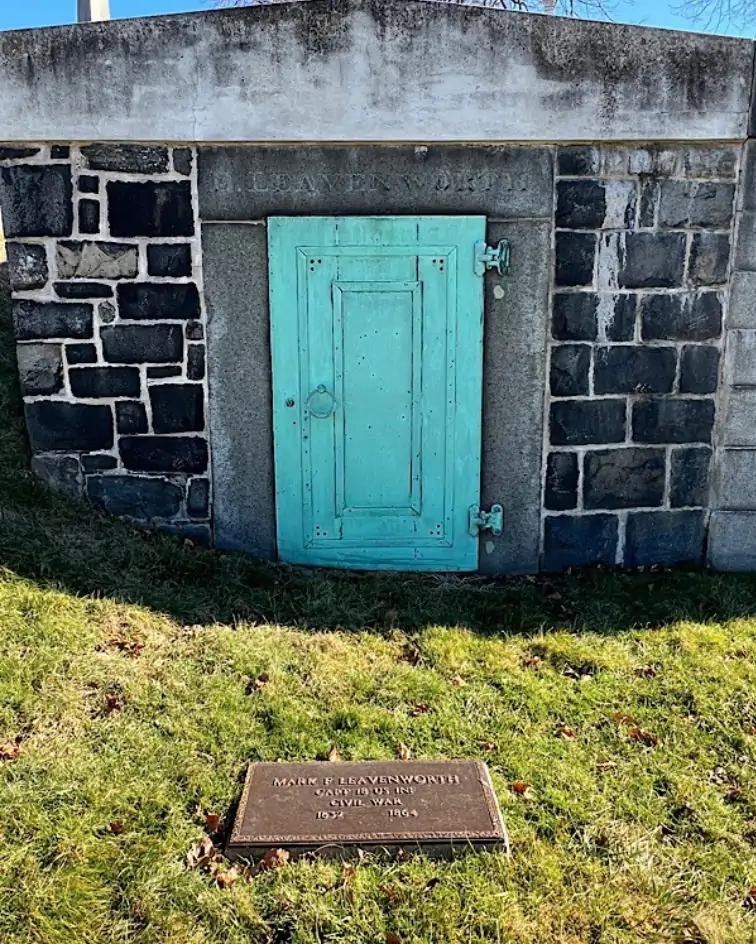
LEAVITT, JR., SHELDON (1844-1921). Captain by brevet; first lieutenant, 4th Massachusetts Cavalry, Company K. Born in Brooklyn, he was a resident of Great Barrington, Massachusetts, when he enlisted as a second lieutenant on April 9, 1864. He was commissioned into the 4th Massachusetts Cavalry on April 29. Leavitt rose to first lieutenant on February 1, 1865, and was brevetted to captain two months later on April 9. His commanding officer, John Gibbon, major general of United States Volunteers, also recommended that Leavitt be brevetted to captain in his letter of June 2, 1865, citing, “…gallant and distinguished services during the late campaign [at Appomattox].” He resigned on August 9 of that year. His last residence was in Ashton, North Carolina. Section 90, lot 421.
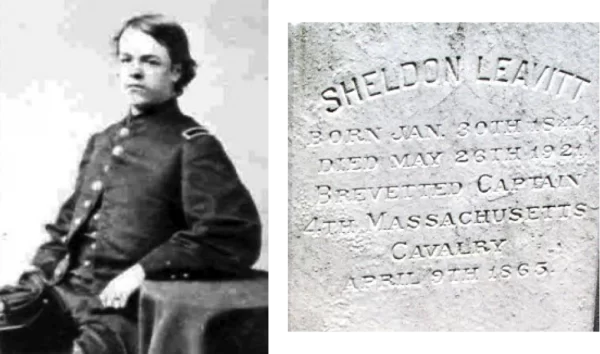
LeBOURVEAU (or LeBOREAU, LeBOURVEAN), THEODORE L. (1837-1907). Rank unknown, United States Navy. LeBourveau was born in New York City. In June 1861, he enlisted at the Naval Rendezvous at New York City. At that time, it was indicated that he had a light complexion. The 1890 Veterans Census confirms his service during the Civil War and notes that he served for nine months and was discharged in 1862.
As per the New York City Directories for 1876-1878 and 1877, LeBourveau was a laborer working in stone. During those years, he lived at 244 East 45th Street. He applied for and received a pension from the Navy, certificate 9235. Section 128, lot 21502, grave 34.
Le CLAIR, CASWELL (1844-1911). Private, 158th New York Infantry, Company B. Le Clair was a Brooklynite by birth and a printer by trade. He enlisted at Brooklyn as a private on August 18, 1862, and mustered into the 158th New York on August 29. As per his muster roll, Le Clair was 5′ 8″ tall with blue eyes, dark hair and a fair complexion. His muster roll notes that he was sick at Mansfield Hospital from October through December 1864, and returned to his company on February 27, 1865. Le Clair was discharged from military service on June 30, 1865, at Richmond, Virginia. In 1871, he applied for and received an invalid pension, certificate 1,115,508. His last residence was 358 Bridge Street in Brooklyn. He died of heart disease. Section 128, lot 121807, grave 227.
LEDIARD, HOWARD D. (1847-1897). Private, 56th Regiment, New York State National Guard, Company H. Originally from the West Indies, Lediard served in his unit for 100 days in 1864. Likely a relative of Perry Lediard (see), he last lived at 387 6th Street in Brooklyn. He succumbed to typhoid fever. Georgie A. Lediard applied for and received a widow’s pension in 1897, certificate 468,074. Section 152, lot 18664, grave 11.
LEDIARD, PERRY M. (1841-1899). First lieutenant, 90th New York Infantry, Companies B and C; private, 71st Regiment, New York State Militia, Company A. Born in British Guiana, he served for three months with the 71st Regiment’s State Militia in 1861. He re-enlisted as a private at New York City on September 28, 1861, and mustered into the 90th New York, Company B, two weeks later on October 11. Promotions followed throughout his service beginning with first sergeant on an unknown date, corporal on December 28, 1861, sergeant on September 1, 1862, second lieutenant on October 1, 1863, effective upon his transfer to Company C, and first lieutenant on June 11, 1864. He mustered out at New York City on December 10, 1864. In 1880, he applied for and was granted an invalid pension, certificate 266,217. Most likely, he was a relative of Howard Leidard (see). A resident of Brooklyn, he lived at 405 Bedford Avenue prior to his death from pneumonia. Section 152, lot 18664, grave 7.
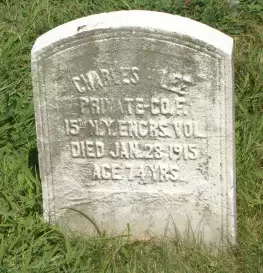
LEE, CHARLES H. (1840-1915). Private, 15th New York Engineers, Company F. His government-issued gravestone records his service as a private in Company F of the 15th New York Engineers. Further details of his military record are unknown. His last residence was 1222 East 40th Street in Brooklyn. Section 126, lot 5047, grave 948.
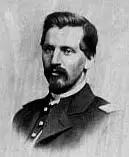
LEE, CHARLES THOMAS (1839-1915). First lieutenant, 7th Massachusetts Infantry. A machinist and resident of Taunton, Massachusetts, Lee enlisted as a sergeant on June 15, 1861, and mustered immediately into Company F of the 7th Massachusetts. Rising through the ranks, he became a second lieutenant on December 7, 1862, and was promoted to first lieutenant on May 8, 1863. He was wounded at Wilderness, Virginia, on May 5 or May 6, 1864, was transferred to Company D of his regiment on an unstated date, and mustered out with that company at Taunton, Massachusetts, on June 27, 1864.
After the Civil War, Lee was a florist in South Brooklyn for 35 years. In 1900, his application for an invalid pension was granted, certificate 1,048,879. His last address was 340 48th Street in Brooklyn. His death was caused by septicaemia. His widow received a pension in 1915, certificate 851,648. Section 135, lot 27263, grave 2179.
LEE, HENRY A. (1840-1916). Corporal, 13th Regiment, New York State Militia, Company A. Lee was born in Brooklyn where he enlisted as a private on April 23, 1861, and mustered into the 13th Regiment. He was promoted to corporal before he mustered out three months later on August 6. A member of the Gouverneur K. Warren Post #286 of the Grand Army of the Republic, he was employed as a clerk. He last lived on Bainbridge Street in Brooklyn. His death was attributed to apoplexy. Section 183, lot 19390.
LEE, HENRY MILES (1827-1899). Chaplain, 13th Regiment, New York State Militia. A native of England, Lee first served in the 13th Regiment as a second lieutenant in 1857 and then as a chaplain in 1860. During the Civil War, he enlisted as a chaplain at Brooklyn on April 23, 1861, and was commissioned into the Field and Staff of the 13th Regiment on May 17. He mustered out on August 6, 1861, at Brooklyn. Although some records state that Post #21 of the G.A.R. was named in his honor, it was actually named for Captain Henry R. Lee of the 173rd New York Infantry. In fact, Henry M. Lee was a member of the Winchester Post #197 of the G.A.R. and, at one point, held the position of commander. As per his death certificate, he was a retired merchant. He last lived at 109 East 175th Street in the Bronx. His death was caused by pneumonia.
In 1905, Emily Lee, his second wife, applied for and received a widow’s pension, certificate 614,030. As per her pension application, Lee had $1,700 in life insurance at the time of his death which she used for her support and a $1,000 mortgage on her house. Among the numerous documents that Mrs. Lee filed in support of her pension application was an affidavit that her husband never filed for a pension, a statement from the officiant at her marriage in 1866 in Athens, New York, and personal letters and documents from acquaintances and her step-daughter, Nellie G. Klencke, attesting to her character and marriage status. (Lee’s sister verified the financial information in another statement. At the time of her application, Emily Lee had $815 in the Greenwich Savings Bank in Manhattan and $715 in the Dime Savings Bank in Brooklyn.) Emily Lee’s original pension of $8 per month was increased to $20 per month in 1916. Section 94, lot 11165.
LEE, JAMES J. (1838-1874). Private, 173rd New York Infantry, Companies G and D. Originally from England, Lee enlisted at Brooklyn as a private on September 9, 1862, mustered into Company G of the 173rd New York on October 30, and transferred into Company D on March 1, 1864. Taken as a prisoner of war on April 9, 1864, at Pleasant Hill, Louisiana, he was paroled at an unstated place on May 27, 1865. He was discharged on July 20, 1865, at New York City. His last residence was in Bay Ridge, Brooklyn. He died from pneumonia. Section 186, lot 18930.
LEE, JOHN C. (1833-1885). Captain, New York Union Coast Guard, Company H; 99th New York Infantry, Companies I and A. Lee enlisted as a captain on May 28, 1861, at New York City, was commissioned into Company H of the New York Coast Guard on June 14, 1861, and was discharged two months later on August 30. On January 17, 1862, he was reappointed as a captain and was commissioned into Company I of the 99th New York. On June 14, 1864, he was given an intra- regimental transfer to Company A. Lee was discharged on February 7, 1865. His last address was 108 3rd Place, Brooklyn. He succumbed to pneumonia. In 1890, his widow applied for and was granted a pension, certificate 432,258. Section 2, lot 5499, grave 1348.
LEE, LUCIUS J. W. (1835-1901). Medical staff. Lee was born in Easton, Pennsylvania, where he received his elementary school education. According to his obituary in The New York Times, he served on the medical staff of Douglass Hospital in Washington, D.C., during the Civil War. He graduated with a medical degree from the University of Pennsylvania some years after the hostilities. A prominent physician in Brooklyn for 27 years, he was an authority on stomach ailments. As per his obituary in the Brooklyn Daily Eagle, he was a member of the Royal Arcanum. His last address was 655 Quincy Street in Brooklyn. His death was caused by pneumonia. Section 154, lot 24126, grave 3.
LEECH, JOHN (1842-1885). Private, 127th New York Infantry, Company D. Leech enlisted on July 30, 1862, and mustered in on that date. He deserted on an unknown date. He last resided at 54 Livingston Street in Brooklyn. Enteritis was the cause of his death. Section 2, lot 567.
LEECH, RICHARD B. (1841-1899). Paymaster’s clerk, United States Navy. According to his obituary in the Brooklyn Daily Eagle, Leech, who was born in Brooklyn, was the son of an alderman. A paymaster’s clerk during the Civil War, he enlisted on May 1, 1861, served in the South Atlantic Squadron aboard the USS North Carolina and Courier, and was honorably discharged on July 5, 1863.
Leech then entered the leather business, was a bookkeeper as per the 1870 Brooklyn Directory, and subsequently opened a coal yard in downtown Brooklyn in 1871 which he operated until 1890. Leech applied for and received a pension from the Navy under certificate 18,524. The 1890 Veterans Census confirms his service during the Civil War. He was a member of the Winchester Post #197 of the Grand Army of the Republic (G.A.R.) and the South Atlantic Squadron Association.
Active in Republican Party politics and an alderman for two terms, Leech was renowned as a storyteller and after-dinner speaker. While attending a reunion of the 48th Regiment’s Veteran Association (of which he was a member) at the Brighton Beach Hotel, he spoke about the Navy during the Civil War, and then succumbed to a heart attack. His last residence was 51 Putnam Avenue, Brooklyn. In 1900, his widow, Georgianna Leech, applied for and received a pension. Section 83, lot 2351, grave 1.
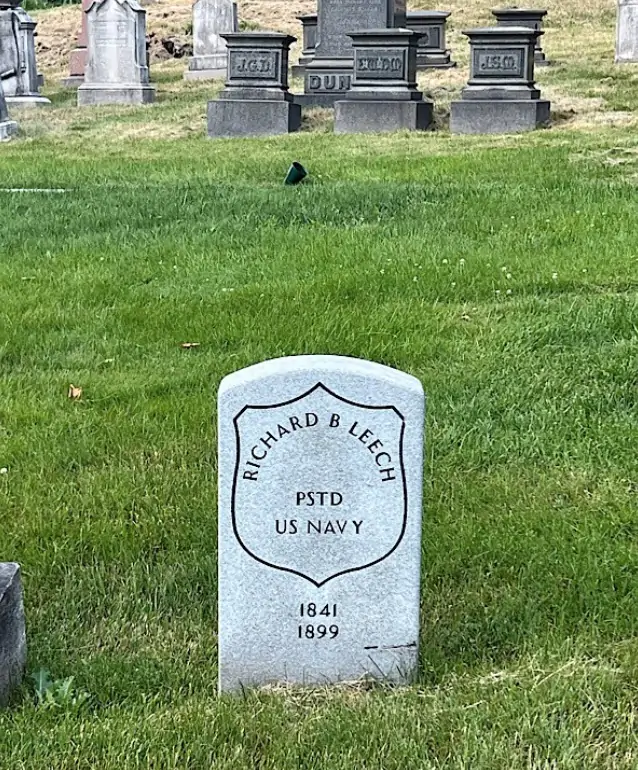
LEEDS, JAMES M. (or H.) (1838-1873). Sergeant, 163rd New York Infantry, Company B; private, 73rd New York Infantry, Company I. Born in New York, Leeds first served in the 163rd New York. He enlisted at New York City as a sergeant on July 28, mustered into the 163rd on October 10, and transferred into the 73rd New York as a private on January 18, 1863. He last lived at 229 West 45th Street in Manhattan. He died of gastritis. Section 119, lot 501.
LEEDS, JAMES W. (1822-1887). Captain of the forecastle, United States Navy. Originally from Warren, Maine, Leeds enlisted at Brooklyn on August 25, 1862, and served as a seaman in the Navy until his discharge at Hampton Roads, Virginia, from the USS Savannah on August 24, 1863. He re-enlisted on December 7, 1863 and was discharged on December 7, 1864. He served aboard the USS Brandywine, was the captain of the hold on the USS Monticello when it captured the brigs Revere, Sue, and Odd Fellow. He was the captain of the forecastle aboard the USS Metacomet when it captured three brigs. He was on the USS Savannah, and serving as its captain of the forecastle, when he was discharged. His last residence was 33 Cumberland Street in Brooklyn. His death was attributed to senile debility. In 1890, his widow, Catherine, applied for a pension in Kings County. Section 45, lot 9497.
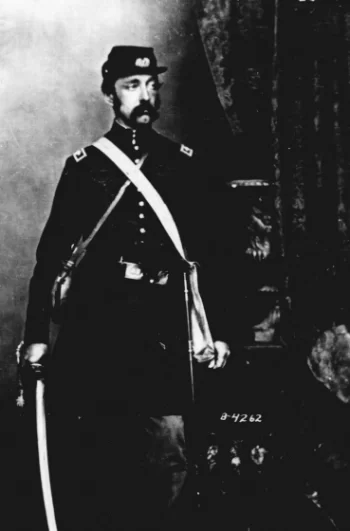
LEFFERTS, MARSHALL (1821-1876). Colonel, 7th Regiment, New York State Militia. A member of an old German family from Long Island, Marshall Lefferts moved to New York City at the age of 15 and worked as a clerk for an importing company. He developed an interest in the telegraph and advanced quickly in this new industry to become engineer of the American Telegraph Company (the first company to use women in the telegraphic service). In his ground-breaking work, he surveyed the City of Brooklyn including Green-Wood, was involved in the construction of telegraph lines from New York City to Boston and Buffalo, and pioneered the use of instruments to detect electrical faults.
Lefferts enlisted in the New York State Militia in the 1840s, joined the 7th Regiment in 1852 and was elected its colonel in 1859. The regiment was composed of the wealthy and social elite of New York City and Lefferts was in command when the 7th marched down Broadway, the first regiment to leave New York City for duty at the outbreak of the Civil War, assigned to protect the nation’s capital. Their journey to Washington required detours, delays, and the repair of rail lines destroyed by the rebels, but they arrived on April 24, 1861, to the grateful welcome of the local citizens and President Lincoln. With the title of general, he was military governor of the district in Frederick, Maryland.
He mustered out at New York City on June 3, 1861, but he rejoined the regiment on May 25, 1862, when it was part of the National Guard, and served until September 5, 1862. He also commanded the 7th Regiment the following year, mustering out on July 20, 1863, after his regiment was called to restore order to New York City following the Draft Riots.
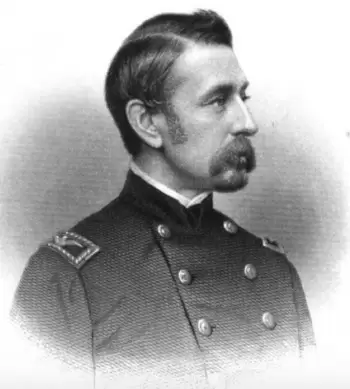
After the War, Colonel Lefferts returned to the telegraph business, and also managed news and financial information services for the Gold and Stock Telegraph Company which purchased Western Union in 1871. On his way to lead the 7th Regiment in the American Centennial parade to be held in Philadelphia on July 4, 1876, he suddenly took sick on the train and died the day before the festivities. He was commandant of the Veteran Association of the National Guard, which passed a resolution in his honor: “That of all the men who have ever been connected with the Veteran Association and the Seventh Regiment, General Marshall Lefferts was foremost among those who have consecrated themselves to the best interests of these commands.” At the request of his widow, there was no military display at his funeral, but officers of the regiment left Philadelphia to be present at the services. A resident of 336 West 22nd Street, Manhattan, he died in Jersey City, New Jersey. Section 8, lot 7363.
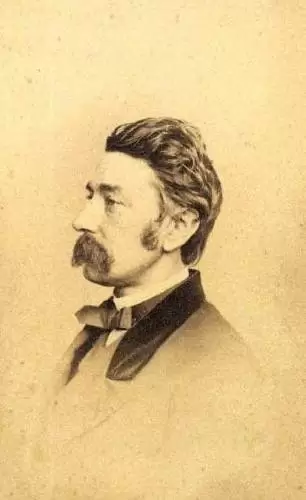
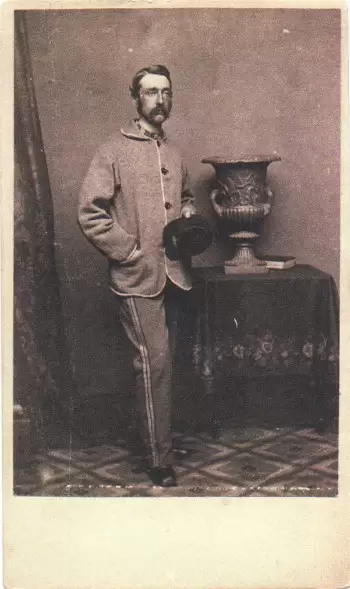
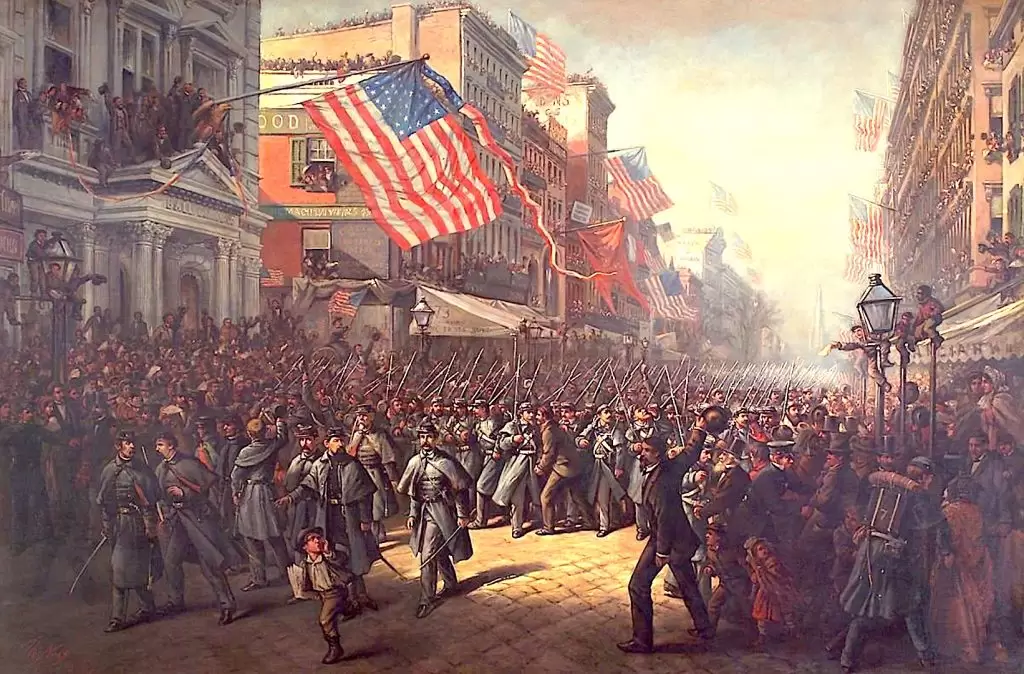
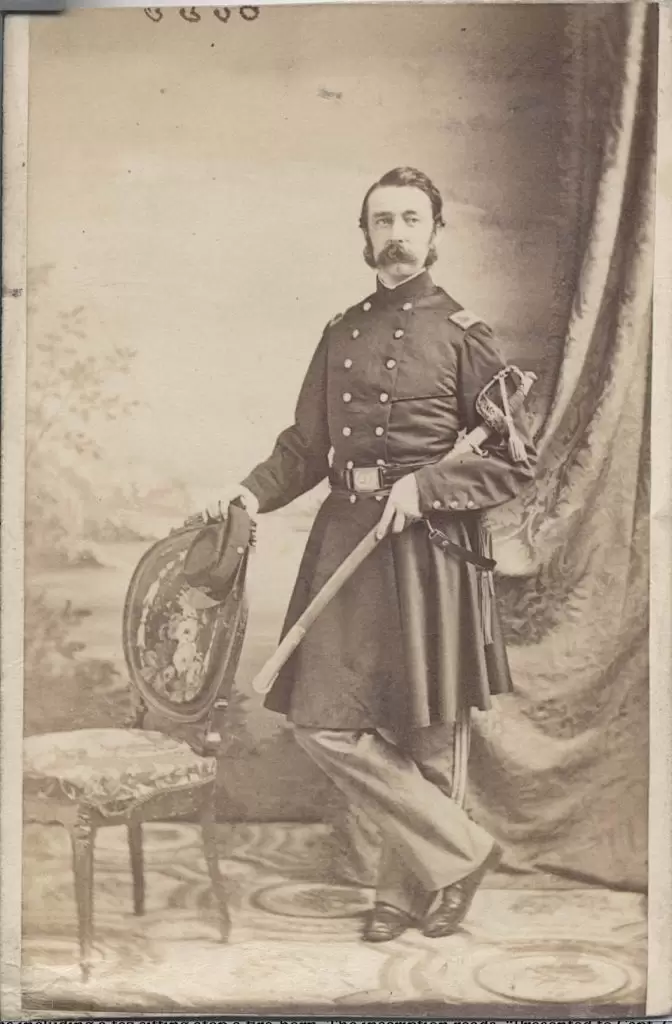
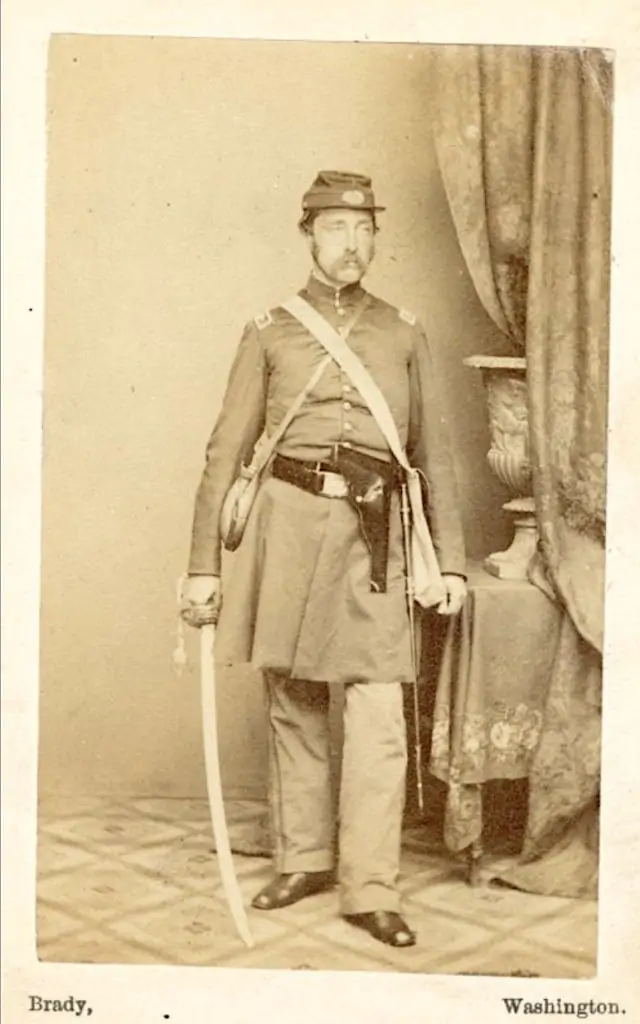
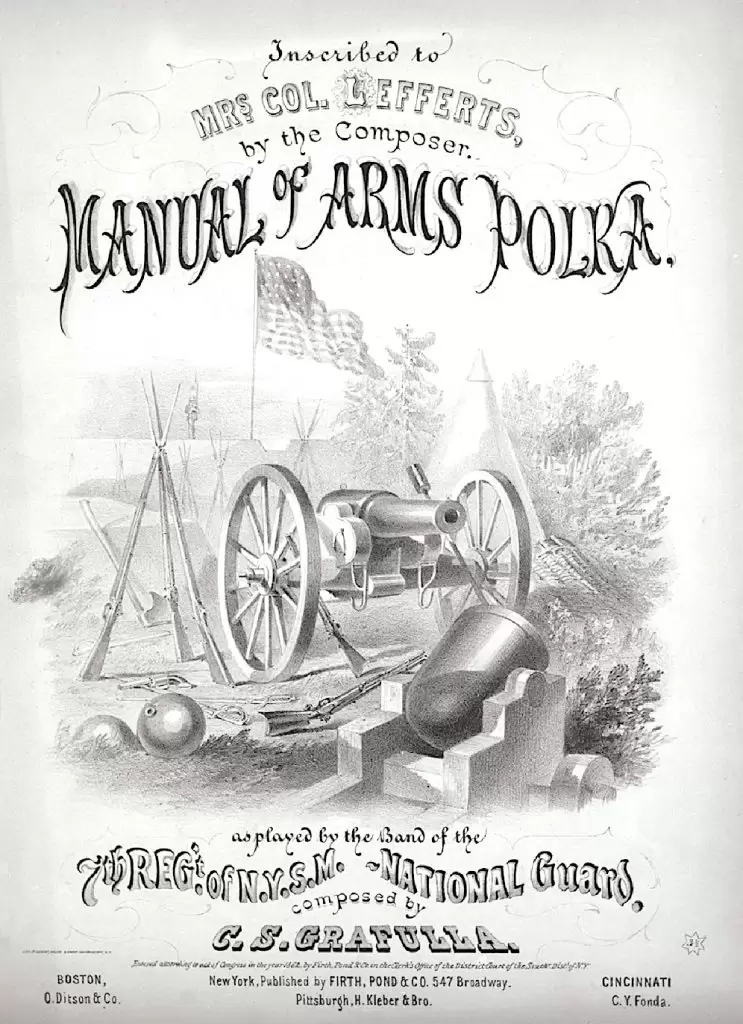
LeFORT, GEORGE (1829-1864). Captain, 73rd New York Infantry, Company D; private, 7th Regiment, New York State Militia, Company A. A native New Yorker, the census of 1850 indicates that he was a hatter; the census of 1860 states that he was an expressman. LeFort served for 30 days in the 7th Regiment in 1861. He re-enlisted as a first lieutenant on June 3, 1861, at Camp Scott, New York, was immediately promoted to first lieutenant and adjutant, and was commissioned into the 73rd New York’s Field and Staff on September 5 of that year. He was promoted to captain two months later on November 20 and transferred that day to Company D. Held in high regard by his men, he was given a silver-tipped foot officer’s presentation sword made by Ball Black & Co. of Hartford, Connecticut with a 23 inch blade, dated 1862, made by Collins & Company of Hartford. Among the high-grade embellishments are an armed Zouave soldier, and a detailed stand of arms including a fez sitting atop a fire-horn. The inscription reads, “Presented to Capt. George LeFort/by the non-commissioned officers and privates/of Co. D, 4th Regt. Excelsior Brigade/2nd Fire Zouaves/as a testimonial of their esteem for him as a/soldier and a gentleman.”
LeFort participated in the Battles of Fredericksburg and Chancellorsville in Virginia, and Gettysburg, Pennsylvania (where he served as acting inspector general on the staff of Colonel William R. Brewster (see)). Although severely wounded at Gettysburg at the beginning of July, he rejoined the regiment at Wapping Heights, Virginia, on July 23, where his gallantry was recognized in battle reports. Brigadier General Andrew A. Humphreys, United States Army, acknowledged him in his field report from Army of the Potomac Headquarters on August 16, 1863, mentioning that he “…was very active in the field, and behaved in the most gallant manner, conveying my orders under the hottest fire.” Humphreys noted that LeFort was wounded in action and was “obliged to leave the field before the action was over…” After fighting at the Wilderness and Spotsylvania, Virginia, in May 1864, he was mortally wounded by gunshot later that month at North Anna River, Virginia, on May 20, and died that same day at the regimental hospital. All told, he participated in nearly 40 engagements, and, although offered promotions and other regiments, he preferred to remain a captain with his unit. His obituary in the Brooklyn Daily Eagle confirms his Civil War service and death in action. Margaret LeFort, who is interred at Green-Wood, applied for and received a widow’s pension on June 4, 1864, certificate, 72,163. LeFort’s presentation sword was listed in 2014 for sale at $39,500. Section 46, lot 12099.
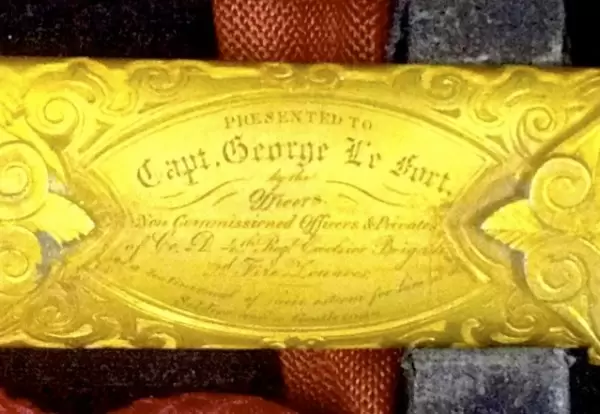
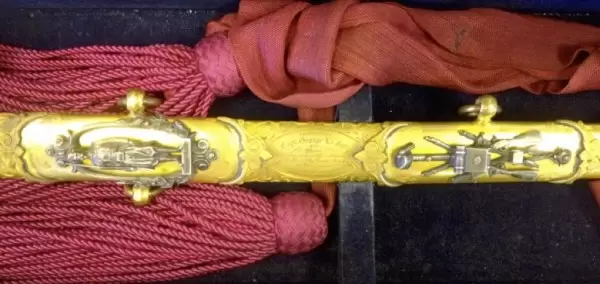
LEGGETT, RICHARD LEE (1831-1905). First lieutenant, 7th Regiment, New York State Militia, Company C. Born in New York City, he enlisted as a sergeant on April 17, 1861, to serve for 30 days and mustered into Company C of the 7th Regiment on April 26. He mustered out on June 3 at New York City. On May 25, 1862, he re-enlisted for a period of three months and was commissioned into the same regiment and company, now part of the New York State National Guard, as a second lieutenant. He mustered out on September 5 at New York City. On July 3, 1863, he re-enlisted a third time at Baltimore, Maryland, for a tour of 30 days, was commissioned as a first lieutenant on July 20, returned to the same company, and mustered out at New York City. After the War, he resumed business as a wholesale grocer at 49-51 Park Place, Brooklyn. In 1878, he ceased operations after having been in the business for 18 years, citing financial problems. He last lived at 281 Adelphi Street. The cause of his death is attributed to hyper prostate. Section 183, lot 20389, grave 5.